
Compiled by
Janet Jaguar
1. Log Book
Abbreviations Compiled
for Royal Navy, World War 1-era
(Some
of these abbreviations are also used for Old
Weather Phase 3 ships)
There is also a very good list of
modern RN abbreviations online, which
may be quite helpful.
Symbols
These are some of the symbols we often find in the
logs. Since we can't
add images to our transcriptions, we need to know what
they mean in order to
transcribe them. This list should make things easier.
96o 13' 26.4" N - an
example of Longitude geographic coordinates. See
Wikipedia
article. When transcribing, replace the
symbols with spaces: 96 13 26.4N
- o
- Degrees of Arc.
360 degrees are the
circumference of the Earth, varying in measured
units of length depending
on position on the globe. This may also be written
as a decimal,
eliminating the need for the minutes' and seconds'
numbers.
- ' - Minutes of Arc. There are 60 minutes in one degree of arc. This
may also be written as a decimal, eliminating the
need for the
seconds' number.
- " - Seconds of Arc.
There are 60 seconds in
one minute of arc.
13' - an example of recording distance.
- '
- Nautical miles.
The nautical
mile is a unit of length that
is about
one minute of arc of longitude along any meridian.
Transcribe this as
written.
2600x
- an example of
recording distance.
- x
- Yards.
A unit of length equaling 3
feet or 0.9144 meters. Transcribe this as 'x'.
~ - "illegible". Used by
Old Weather transcribers to indicate an indecipherable
letter or number.
 -
Abeam.
Transcribe this as
"abeam". -
Abeam.
Transcribe this as
"abeam".

 -
Abeam port.
Transcribe this as "abeam
port". -
Abeam port.
Transcribe this as "abeam
port".
 -
Abeam starboard.
Transcribe this as "abeam
starbd". -
Abeam starboard.
Transcribe this as "abeam
starbd".
 -
Anchor.
(2 examples shown.) Transcribe this as "anchor". -
Anchor.
(2 examples shown.) Transcribe this as "anchor".
 -
Double anchored.
Ship anchored with both port and
starboard anchors (2 examples shown.) Transcribe this
as "double
anchored". -
Double anchored.
Ship anchored with both port and
starboard anchors (2 examples shown.) Transcribe this
as "double
anchored".
 +"age"
-
Anchorage.
Transcribe this as "anchorage". (Logs use just one
symbol, not the two examples shown here.) +"age"
-
Anchorage.
Transcribe this as "anchorage". (Logs use just one
symbol, not the two examples shown here.)
 -
Port Bower Anchor.
Transcribe this as "port
bower anchor". (An example of fancy and extended use
of the symbol,
not common.) -
Port Bower Anchor.
Transcribe this as "port
bower anchor". (An example of fancy and extended use
of the symbol,
not common.)
 -
Starboard Bower
Anchor.
Transcribe
this as "starb'd bower anchor". (An example of fancy
and
extended use of the symbol, not common.) -
Starboard Bower
Anchor.
Transcribe
this as "starb'd bower anchor". (An example of fancy
and
extended use of the symbol, not common.)
 -
Moon, rise or set
location.
Usually
used to identify a bearings point. Transcribe this as
"moon". The same symbol is used morning and evening. -
Moon, rise or set
location.
Usually
used to identify a bearings point. Transcribe this as
"moon". The same symbol is used morning and evening.
 -
Sun, rise or set
location.
Usually
used to identify a bearings point. Transcribe this as
"sun". The same symbol is used morning and evening.
The dotted circle alone (no
horizon line) is also used as a noun; example: "Darken
the ship at 'sun'
set." -
Sun, rise or set
location.
Usually
used to identify a bearings point. Transcribe this as
"sun". The same symbol is used morning and evening.
The dotted circle alone (no
horizon line) is also used as a noun; example: "Darken
the ship at 'sun'
set."
Example of morning reading (sunrise):

Example of evening reading (sunset):

 -
Star.
Usually used to identify a method
of obtaining observed LatLong. Transcribe this as
"star". May
also be shorthand for "starboard" as in "let go
starboard
anchor" Example: -
Star.
Usually used to identify a method
of obtaining observed LatLong. Transcribe this as
"star". May
also be shorthand for "starboard" as in "let go
starboard
anchor" Example:

 -
Triangulation point.
Usually used to identify a ship's
position and attitude while at anchor. Transcribe this
as "triangulation
point". There is a
professional definition here in the forum. Example: -
Triangulation point.
Usually used to identify a ship's
position and attitude while at anchor. Transcribe this
as "triangulation
point". There is a
professional definition here in the forum. Example:

0 - 9
3 pdr - 3 pounder (gun) Example:
Exercised guns crew at 3 pdr with common shell.
6" BL - 6 inch Breach Loading
(cannon).
6 P.R.Q.F. - 6 Pounder Quick Firing
(cannon).
A - B
A.B. or AB - Able Bodied Seaman, a higher skill
rating than Ordinary Seaman.
abm. - Abeam. Example: [HMS
Caronia], [July 14, 1915]. "Georges Id. abm. Stopped."
ABS - Armed boarding steamer;
(smaller hired merchant ship)
A.D. or AD - Artificer Diver.
AMC - Armed merchant cruiser (hired
merchant ship)
A/C - Altered Course. Example:
Albion, 1914-07-17, 11 AM. 11.40 Lizard Lt. N43E3' a/c
S87E
http://oldweather.s3.amazonaws.com/ADM53-33214/ADM53-33214-007_1.jpg
AG - Armed Guard
Ah. - Ahead
AoF - Admiral of the Fleet
Ast. Pay. or
A.P. - Assistant Paymaster.
A.P. - Armour Piercing.
A.T.S. - Apparent Time at Ship Example: [HMS
Caronia], [July 7, 1915, 9.0am]. "Time back 31 mins.
to
A.T.S." See also S.A.T.
ATP - Authorised to Proceed (when
boarded vessels were allowed to proceed)
Bea or Bcn - Beacon. Example:
HMT
Tenby Castle, 7 August
1915 @ 02:00-03:00 left margin.
B/G or bgs or Brg - bearing(s).
BISN or B.I.S.N. - British India Steam
Navigation Company
Bque - Barque
Bks. - Barracks
BL or B.L. - Breech Loader (Breech
Loading gun).
BS or B.S. - Battleship Squadron.
BW or B.W. - Breakwater
OR
BW or B.W. - Both Watches
BW for x - Both watches for excercise
BOT or B.O.T. - Board of Trade; aka
"Lords Commissioners of Trade and Plantations",
English governmental advisory body.
Also the very different American futures and options
commodities exchange.
C - D
C. of P. - Captain of Port
CERA - Chief Engine Room Artificer. Example:
HMS Albion, 1914-08-06, 3 PM. 1.55. 1 C.E.R.A. joined
from depot.
http://oldweather.s3.amazonaws.com/ADM53-33214/ADM53-33214-015_0.jpg
comed - Commenced Example: "Comed
coaling."
C in C - Commander in Chief.
CM. - Court Martial, as in "CM
prisoner left ship under escort).
Co. - Course. Example: [HMS
Caronia], [July 12, 1915]. "7.55 Finished, weighed
(anchor) and Proceeded
72 revs. Co. S48E."
C.O.E. - Church of England.
Coy - Convoy.
C.P.O. - Chief Petty Officer.
Corpl. Or Cpl. - Corporal a rank
above private in the RMLI. Example: Corpl.Guerin
R.M.L.I. injured in stbd
collier + sent to H.M.H.S. "Berbice".
C.S. - Cruiser Squadron. Example:
"[Course] as reqd with 7th C.S. to form screen East of
2nd B.S. at
5'."
CT - Coal Trimmer; merchant seaman
rating for RN Trimmer rating; exists in crews on
merchant cruisers.
D. - Diver.
OR.
D. - Discharged.
DC - Depth Charge(s).
DH - Deck Hand(s).
D.M.B. - Duty Motor Boat.
DR or D.R. Post - Dead
Reckoning or Dead Reckoning Position.
D.S.B. - Duty Steam Boat. The
ship's steam pinnace that will be kept fired up to run
all the gofer errands of
the day.
Detention Bks - Detention Barracks.
DD - Discharged Dead from service.
DAMS - Defensively Armed Merchant Ship
(World War I). From the acronym finder which
contains 4M of the
things.
Dev'n - Deviation. Example:
[HMS Endeavour], [October 1921].
http://forum.oldweather.org/index.php?topic=751.0;topicseen
disEmbk - Disembark.
do - Ditto.
DOW - Died of Wounds.
DY - Dockyard.
D.S.M. - Distinguished Service Medal
E - F
EA - Electrical Artificer
EAR - Engines as required; Example:
Macedonia, "EAR to manoeuvre closer to "Glasgow" "
empd or empd - Employed
EQ - Evening Quarters
ERA - Engine Room Artificer. Example: HMS
Albion, 1914-08-05, 7 PM. 7.30. 2 E.R.A.s joined ship
from depot.
Exd - Exercised. Example: Juno,
1915-06-08 5 PM. Exd fire stations
http://oldweather.s3.amazonaws.com/ADM_53-45459/ADM%2053-45459-007_0.jpg
Example: Albion, 1914-07-17, 2 AM. Exd sounding Pty
& placing oil ~
exch. - exchanged. Example:
Challenged and exch. pdts with HMS "Mantua".
F.G. - Fishing Ground (origin or
destination of a boarded vessel)
FM - Fireman; merchant seaman rating
for RN Stoker rating; exists in crews on merchant
cruisers.
OR.
FM - Fleet Messenger ship.
fath or fms or fthms - Fathoms; a
unit of length used especially for measuring the depth
of water. There
are 2 yards (6 feet) in a fathom.
F.W. - Fresh water
fxl or fxle or fo'c'stle - Forecastle
G - H
G - (with a number as a
bearing) Green; part of
a
bearing
relative to the ship's course of
a sighted vessel or
landmark, green being the color of the navigation
running lights on the
starboard side of a ship. Example: [HMS Macedonia]
"sighted HMS
Edinburgh Castle G.14."
G.C. - Gun Crew
GLs - Gunlayers
G.M. or GM - Gunner's mate.
OR.
G.M. or GM - Grog money.
GQ or GQs - General Quarters
GS or G.s. - General Service; many
types of kit and hardware that couldn't otherwise be
easily categorised.
Grt or Gr or Gt - Great
Harbr. - Harbour
HBM - His Britannic Majesties, as in
"HBM Consul boarded".
H.E. (shell) - High Explosive.
Example: Lost overboard: 3 6" Q.F. common shell + 1
H.E. shell Q.F.
OR
H.E. - His or Her Excellancy
H.I.J.M.S. - His Imperial Japanese
Majesty's Ship
HIRMS - His Imperial Russian Majesty's
Ship; "HIRMS Oleg"
HMA - His Majesty's Auxiliary; i.e.
a ship in the RFA, "HMA Osmanich"
HMAS - His Majesty's Australian Ship;
"HMAS Torrens"
H.M.A.T. - His/Her Majesty's Australian
Transport Example: top, sent boat with orders
to HMAT's "Lord
Landsdowne" + "T. Stratton"
HMCS - His Majesty's Canadian Ship;
"HMCTBD Grilse - His Majesty's Canadian Torpedo Boat
Destroyer"
HMD or HMTBD - His/Her Majesty's
Destroyer.
HMS - His/Her Majesty's Ship.
H.M.H.S. or H.S. - His/Her Majesty's
Hospital Ship. Example: Corpl.Guerin R.M.L.I.
injured in stbd collier +
sent to H.M.H.S. "Berbice".
HMT - His Majesty's Transport;
"HMT Olympic"
H.M.Y. - Her/His Majesty's Yacht
H.P. - Harbour Patrol (boat)
I - L
Id. - Island.
Inc. - Increase. Example: HMS
Caronia, July 24, 1915. "8.0 Inc. to 55 revs."
Int'd - Intercepted.
K.H.M. - King's (or Queen's)
Harbourmaster; when a Royal Navy officer serves
in this capacity at a Naval
port, they are known as the Queen's (or King's)
Harbourmaster, and is entitled
to fly a white-bordered Union Flag with a white
central disc bearing the
initials "QHM" (or "KHM" during the reign of a King)
beneath a crown.
Kts. - Knots; speed in nautical
miles/hour (1 nautical mile equals approx. one minute
of arc of latitude,
exactly 1,852 metres, and approx. 6,076 feet).
L Bg - Light Barge.
L.C.S. or LCS - Light Cruiser Squadron.
L.T.O. or LTO - Leading Torpedo Man.
Lt. or Lt.Ho. or L.H. - Lighthouse. Example:
Albion, 1014-07-17, 11 AM: 11.40 Lizard Lt. N43E3' a/c
S87E
http://oldweather.s3.amazonaws.com/ADM53-33214/ADM53-33214-007_1.jpg
Or.
Lt - Little. Example: Lt Cumbrae abm 1/4'.
L.V. or Lt.V. - Light Vessel (an
anchored boat that acts as the areas light house)
Example: HMS Caronia,
Ambrose L.V. aided navigation in front of New York
harbor.
Lt. or Lieut. - Lieutenant
Lt. Cdr. - Lieutenant Commander
Ldg.Sig. - Leading Signaler
M
- N
(m) or (M) - Following a sighted
bearing, magnetic.
M.A.A. - Master at Arms; the senior
CPO and responsible for all discipline aboard, a very
important man indeed.
MFA - Merchant Fleet Auxiliary;
"MFA Osmanich"
Mag - Magnetic. "Relative
to Earth's North Magnetic Pole."
m. - Minutes
M.D. - Main Derrick.
M.D.(&)H.B. - Mersey Dock &
Harbour Board.
MMR - Mercantile Marine Reserve
(British); also the wholly American Merchant Marine
Reserve.
M.V. or MV - Motor Vessel. Example:
"Stopped, boarded Danish M/V Falstria"
(N) - Navigating Officer indicated when after
officer's rank.
N.D.S. - Night Defence Station.
Example: Sounded off N.D.S. Red Watch.
N.S.O. - Naval Stores Office;
example: Torch: "Rec'd 1.5 tons coals, culinary from
N.S.O."
N.U.C. - Not Under Control; a
problem with steering gear or engine; example:
Victorian, "N.U.C. lights
hoisted"
Nor or Norw - Norwegian.
O - P
Obs. - Observed. Example: 5.55
Obs. submarine Lat. 55.18N Long. 6.30W
O-F - Oil Fuel. Example:
(HMS Torch) ".at oiler. Recd 62 tons of O-F."
O.H.M.S. - On His/Her Majesty's Service;
commonly seen on correspondence from government
departments in countries of the
Commonwealth of Nations, recognising the British
monarch as the head of state.
O.O.G. or O. of G. - Officer of Guard
OOW - Officer of (the) watch.
Ord. or O.S. - Ordinary Seaman
Patt. - Pattern. Example: Lost
overboard by accident Columbus Pos'n Lt. patt. no.57
PB or Pb - Patrol Boat
PB or P.B. - Port Bower; referring
to the Port Bower anchor. According to 1928 Websters:
bower anchor =
bower = an anchor carried at the bow.
Pty - Party. Example: Albion,
1914-07-17, 2 AM. Exd sounding Pty & placing oil ~
http://oldweather.s3.amazonaws.com/ADM53-33214/ADM53-33214-007_1.jpg
P.N.T.O. - Principal Naval Transport
Officer - Referred to only on large area depot
ships, like Blenheim. They had to transport entire
crews to and from England to keep the local ships
on station.
P.V. - Paravane - Also called a
"fish", it's an device dragged behind the ship to
clear wires for
minesweeping.
P.L. - Patent Log - A log that is
pulled behind the ship to measure speed.
P.L.A. - Port of London Authority
Example: HMS Naneric, 21 Sept 1918, London "PLA men
handling
moorings"
P.S.N.C. - Pacific Steam Navigation
Company
P&O - "Peninsular &
Oriental" Steam Navigation Company.
P.O. - Petty Officer
P.D. - Physical Drill. Example:
"Boys R&W watches to P.D.& Signals"
P.W. - Port Watch
P.Z. - the code used to give
the order to commence exercises to accustom the two
Squadrons to work together,
to gain practical experience of the difficulties of
signalling to and of
manoeuvring a large fleet. Example: HMS Roxburgh "Now
carrying out P.Z.
exercises, so far negative"
Pt. or P. or Pbd. - Port side of ship.
pdts or pndts - pendants; the
hanging rope or line carrying the ship's ensign
(flag), which is dipped to
acknowledge a passing ship. Example: Challenged and
exch. pdts with HMS
"Mantua".
Proc'd - proceeded Example:
http://oldweather.s3.amazonaws.com/ADM53-39827/ADM%2053-39827-003_1.jpg
Pts - Privates (Lowest rating in
Marines)
Q - R
Q.D. - Quarter Deck. Example:
"1400 Spread Q.D. Awning. 1900 Furled Q.D. Awning"
Q.F. - Quick firing.
R - (with a number as a
bearing) Red; part of
a
bearing relative to the ship's course
of a sighted vessel or
landmark, red being the color of the navigation
running lights on the port side
of a ship. Example: [HMS Macedonia] "observed "Sydney"
R.40."
RA - Rear Admiral.
R.C. - Roman Catholic.
Rds - Rounds (of ammunition).
Example: Gunners storeroom found to have been broken
into. 1 revolver No49278 +
80 Rds ammunition stolen.
Recd - -received Example: "Recd
85 tons coal."
Red. - Reduced.
Remd - Remainder.
reqte - Requisite. Example:
HMS Orvieto, 23 March 1916 @ 06:45 "6:45 Bar end buoy
abm. 15 knots
as reqte through South Edinburgh Channel."
revs. or rev. or revns -
Revolutions. Example: (HMS Caronia, July 6,
1915) "5.0 Red. to
68 revs."
RFA or R.F.A. - Royal Fleet Auxillary. Includes
Oilers and fuel ships.
RFE or R.F.E. - Range Finding Exercise.
Includes Oilers and fuel ships.
RFR or R.F.R. - Royal Fleet
Reserve. See
The
Royal Fleet Reserve and
How to Join It - 1914
RIM - Royal Indian Marine. The
Indian navy before 1934.
RIMS - Royal Indian Marine Ship. The Indian
navy troopships used extensively by the RN.
Rk - Rock. Example: Passed
Dumbarton Rk.
RMA - Royal Marine Artillery.
RMAB - Royal Marine Artillery Barracks.
RMS - Royal Mail Ship; "RMS
Olympic"
RNH - Royal Naval Hospital.
RMLI - Royal Marines Light Infantry. Example:
"Private Carter R.M.L.I. returned from hospital" (http://oldweather.s3.amazonaws.com/ADM53-50910/ADM53-50910-032_0.jpg)
RMS - Royal Mail Ship.
RMSP or R.M.S.P. - Royal Mail Steam
Packet.
RN or R.N. - (British) Royal Navy
RNAS or R.N.A.S. - Royal Naval Air
Service.
RNASBR or R.N.A.S.B.R. - Royal Naval
Auxiliary Sick Berth Reserve.
RNB or R.N.B. - Royal Navy Barracks. Example:
"1 P.O. tel discharged to Portsmouth R.N.B."
RNH - Royal Naval Hospital.
RNO or R.N.O. - (top) Resident Naval
Officer (in a foreign port)
RNR or R.N.R. - Royal Naval Reserve. See
this
link for
requirements to join.
RNVR or R.N.V.R. - Royal Naval Volunteer
Reserve
RNV(W)R - Royal Naval Volunteer (Wireless) Reserve
R.O.B.E. - Rung Off Both Engines. This was the
time of those super things with a big brass handle
that sent a
visual and a bell signal to the Engine Room. Example:
http://oldweather.s3.amazonaws.com/ADM_53-47700/ADM%2053-47700-014_1.jpg
May also be Ran On Both Engines.
R.S.P. - Red Sea Patrol; Example: Received
mails for Perim Kamaran + H.M. ships of R.S.P.
RV - Rendezvous; Example:
Cruising at R.V. awaiting H.M.S. "Patuca".
S
SQMS - Senior Quartermaster-Sergeant
Shkl or Shkles - Shackle or shackles;
A nautical unit used for measuring the lengths of the
cables and chains
(especially anchor chains), equal to 15 fathoms, 90
feet or 27.432 meters.
S.A.A. - Small Arms Amunition.
S.A.T. - Ship's Apparent Time. See
also A.T.S.
SB or S.B. - Starboard Bower;
referring to the Starboard Bower anchor. According to
1928 Websters:
bower anchor = bower = an anchor carried at the bow.
S.B.A. - Sick Berth Attendant.
SBC - Signal Books Correct. (In some
cases it could mean "Seen By Captain".)
SBC - Set Bridge Chronometer -
"The bridge chronometer would not have been the only
chronometer on board
but it was the critical piece and was intended to be
checked by lunar or solar
reading."
S/C - Set Course; Example: "S/C
N58E"
S1BL - Starboard 1 Breech-Loading (Gun)
S.N.O. - Senior Naval Officer
Sd - Sighted.
Stbd or or Stbd -
Starboard side of ship. Example: From HMS
Foxglove log for
14/12/1921 - 1200 "Leave to Stbd watch from
1700 to
0700."
Link:
http://oldweather.s3.amazonaws.com/ADM%2053-77623/ADM%2053-77623-0025_0.jpg
sch - schooner
S.G. or SG - Seaman Gunner.
s'l - sail. Also incorporated
in tops'l, t.g.s'l (topgallant sail), st'ys'l
(staysail), mains'l, etc. See
http://en.wikipedia.org/wiki/Sail-plan
S/m - Submarine.
SMS or S.M.S. - Seiner Majestat Schiff;
German for "His Majesty's [the Kaiser's] Ship"
S.P. - Steam Pinnace.
SSs - Sightsetters.
S.S. - Steamship.
S.T or S/T - Steam Trawler or Steam Tug
OR.
S.T. or ST - Seaman Torpedo Man.
S.W. - Starboard Watch
S.Y. or SY - Steam Yacht.
stn or stns - station(s) Examples: Took Stn. on
Port bow of "Commonwealth". Exercised
"Abandon ship stns".
Sto. Or Stokr. - Stoker.
S.V. or S/V - Sailing Vessel
T - U
(T) - Following a sighted bearing, true.
TBD - Torpedo boat destroyer;
commonly called a "destroyer"
T.C. or TC - Torpedo Coxswain.
OR
T.C. - Training Class;
"Training class at 1pm"
TG - Topgallant sail. One of several
square-rigged sails
T.G.M. or TGM - Torpedo Gunner's Mate.
T.S. or TS - Transmitting Stations. American
term is "Plotting Room" or "Plot". The fire
control room on war ships. See
http://www.dreadnoughtproject.org/tfs/index.php/Transmitting_Station
V - W
Var or Vble - Variable. Example: [HMS Caronia],
[July 27, 1915]. Weather wind direction.
V.A. - Vice Admiral
VRN - Volunteer Royal Navy
Vsl - Vessel
Wr - Weather
WBC - Wound Bridge Chronometer -
"The bridge chronometer would not have been the only
chronometer on board
but it was the criticasl piece and was intended to be
checked by lunar or solar
reading."
W.I.R. - West India Regiment.
W.O. - Warrant Officer.
W.P. - Work Party.
W.S.St. - War signal station Example:
Challenged by Malin Head W.S.St.
W/T has been noted in three separate
contexts, listed below:
W/T - Wireless Telegraphy. Example:
'Discharged to HMS Minotaur, 1 w/t boy and 1 w/t
operator.'
OR.
W.T. - Warrant Telegraphist Example:
Sent boat with Md. Williams, warrent telegraphist to
repair wireless on HMT
"T.Stratton"; 2.25 Stop, sent boat to HMAT "T.
Stratton".
Boat ret. with W/T officer.
OR.
W.T. - Water Tight (doors). Example: [HMS
Caronia], [Nov. 3, 1915] "Tried Stone Lloyd W.T.
doors.
Ex'ed Action & fire stations."
W.T.O. - Wireless Telegraphy Operator. Example:
9.30: Wireless Operators of Ships of Convoy on Board
for Conference. 11.30: WTO's left ship.
X - Y - Z
Y.P. - Yard Patrol. In
American navy yards and around Annapolis, boats used
to actually patrol the harbors and service ships.
ZZ - Zigzagging.
2. Log Book
Abbreviations compiled for US Navy, Revenue
Service/Coast Guard and Coast & Geodetic
Service in the 19th and 20th centuries
(Some
of these abbreviations may also be used for Old
Weather Phase 1/2 ships)
This
list
has been updated for use in Phase 3, USCG Arctic
Ships. If you have any
additions or changes for this list, please post
them in the
Collection of Known Abbreviations topic.
There is also a very good list of
WWII USN abbreviations online, and a
list of abbreviations for
USN Enlisted Ratings which may be
quite helpful. The USCG (US Coast Guard) generally
uses the same ranks
and logs as the US Navy.
A - B
AB - Able-bodied Seaman. A
rank indicating skill level, one grade above
Ordinary Seaman.
abm. - Abeam. Example: [HMS
Caronia], [July 14, 1915]. "Georges Id. abm.
Stopped."
Adm. - Admiral.
AS - Apprentice Seaman ;
(until 1948)
AMC - Armed merchant cruiser (GB -
RN hired merchant ship)
AG or ArmGrd - Armed Guard (RN and
USN)
Asst. - Assistant of Survey. A
senior rank for non-military officers on the
survey ships of the US Coast &
Geodetic Survey.
ATF - Ocean Tug, Fleet
AP - Armour/Armor Piercing. (Both
RN and USN.)
BAT or BATSHIP. - Battleship.
BatRon - Battleship Squadron.
Bgs or Brg - bearing(s).
Bks. or Baks - Barracks
BM - Boatswain's Mate or Boatman's Mate;
also called Coxswain. Boatswain's
mates train, direct, and supervise personnel in
ship's maintenance
duties in all activities relating to marlinspike,
deck, boat seamanship,
painting, upkeep of ship's external structure,
rigging, deck equipment, and
boats. (Wiki) Coxswains are in command of detached
boats and their crews.
BT - Boiler Technician; a naval
rating specializing in boilers.
C - D
c/c - course change.
Capt. - Captain.
Com'g - Commanding as in,
"U.S.Schr."Yukon" G.Bradford, Asst. com'g."
COTP - Captain of Port (USCG)
CM. - Court Martial, as in "CM
prisoner left ship under escort).
CUS - Course.
COX or Cox'n - Coxswain. Pronounced k'ks'n;
The steersman of a boat; a petty officer who has
charge of a
boat and its crew. (Webster's Dictionary 1913)
C.P.O. - Chief Petty Officer.
CWT - Chief Water Tender; the highet
ranked petty officer charged with maintaining
boiler pressure in a ship's
propulsion system.
DD - Destroyer.
.OR.
DD - Dishonorable Discharge.
.OR.
DD - Drydock.
DR or DR Post - Dead
Reckoning or Dead Reckoning Position.
Disemb - Disembark(ed).
DOD - Died of Disease.
DWA - Died of Wounds from Action with
the Enemy.
D.S.M. - Distinguished Service Medal
E - F
Exp - Experience
.OR.
Exp - Express (boiler)
F - Fireman.
FADM - Fleet Admiral.
fath or fms or fthms - Fathoms; a
unit of length used especially for measuring the
depth of water. There
are 2 yards (6 feet) in a fathom.
G - H
GC - Gun Captain
GD - Guard
GDP - Gun Director Pointer
GM or "Guns" - Gunner's Mate
Grt or Gr or Gt - Great
GUN - Gunboat
Gun - Gunner
HBS - Harbor Boat Service
HECP - Harbor Entrance Control Post.
HE (shell) - High Explosive.
HPF - Harbour Patrol Fleet
I - L
Id or Is. or Isd - Island. "Isd"
is typed Is'd
Insp - Inspector.
.OR.
INSP - Inspection.
Instn - Instruction.
Instr - Instructor.
Kn(s) or Kt(s) - Knot(s);
speed
in nautical miles/hour (1 knot equals approx. 1
nautical mile equals approx.
one minute of arc of latitude, exactly 1,852
meters, and approx. 6,076 feet per
hour).
LDS or lds - Landsman; a naval
rating below that of seaman, indicating little
experience at sea.
Lt. - Light
LV - Light Vessel (an anchored boat
that acts as the areas light house) Example:
Ambrose L.V. aided
navigation in front of New York harbor.
LT or Lt. - Lieutenant
LCDR or LtCom - Lieutenant Commander
Lt (jg) - Lieutenant (Junior Grade)
M
- N
(m) or (M) - Following a sighted
bearing, magnetic. RN: unknown
if used by USN
M - Merchant Marine Reserve
MA or MAA - Master at Arms; the
senior CPO and responsible for all discipline
aboard, a very important man
indeed.
Mag - Magnetic. "Relative
to Earth's North Magnetic Pole."
m - Minutes
MC - USN officer designation for Medical
Corps
MM - Machinist Mate; rating
responsible for the continuous operation of the
many engines, compressors,
gears, and other types of machinery onboard ships
and shore installations. They
are responsible for the ship's steam propulsion
and auxiliary equipment and the
outside (deck) machinery. (Wiki)
MMR - Mercantile Marine Reserve
(British); also the wholly American Merchant
Marine Reserve.
MV or M/V - Merchant Vessel.
Example: "Stopped, boarded Danish M/V Falstria"
(N) - Navigating Officer indicated when
after officer's rank.
Nav - Navy or Naval or Navigation(al).
Navig - Navigation; Navigator.
Nite - Night.
O - P
Obs. - Observed.
OD - Officer-of-the-Day
OG - Officer-of-the-Guard (Army)
OIC or OinC - Officer-in-Charge
OOD - Officer-of-the-Deck
ORD - Ordnance. Heavy weapons
of warfare; cannon, or great guns, mortars, and
howitzers; artillery;
sometimes, a general term for all weapons,
ammunition, and appliances used in
war. (Webster's Dictionary 1913.)
PC - Civilian Personnel Division.
(USCG)
.OR.
PC - Patrol Craft.
.OR.
PC or PClk - Pay Clerk.
PCE - Patrol Craft, Escort.
PG - Patrol Vessel, Gunboat
(PH) - placed after a wind direction
Pilot House compass; Vessel rolling
so as to render it unsafe to stand on bridge so
all courses in future are by
the Pilot House compass.
PT - Patrol Vessel, Motor Torpedo Boat.
PY - Patrol Vessel, Yacht.
PB - Port Bower (anchor). According to 1928
Websters: bower anchor = bower = an anchor carried
at the
bow.
PGC - Per Gyrocompass. A
gyrocompass is similar to a gyroscope. It is a
compass that can find true north
by using an electrically powered, fast-spinning
gyroscope wheel and frictional
or other forces in order to exploit basic physical
laws and the rotation of the
Earth. (thefreedictionary.com)
P.L. - Patent Log - A log that is
pulled behind the ship to measure speed.
P.O. - Petty Officer
.OR.
P.O. - Port Officer
.OR.
P.O. - Post Office
PSC - Per Standard Compass.
Q - R
QM or Quart - Quartermaster.
Webster's 1913 Dictionary:
1. (Mil.) An officer whose duty is to provide
quarters, provisions,
storage, clothing, fuel, stationery, and
transportation for a regiment or other
body of troops, and superintend the supplies.
2. (Naut.) A petty officer who attends to the
helm, binnacle, signals,
and the like, under the direction of the master.
Qtr(s) - Quarter(s).
RA or Rear Adm - Rear Admiral.
Rds - Rounds (of ammunition).
Example: Gunners storeroom found to have been
broken into. 1 revolver No49278 +
80 Rds ammunition stolen.
Recd - received Typed Rec'd
Example: "Recd
85 tons coal."
Red - Reduced.
revs. or rev. or revns -
Revolutions per minute.
RKO - Range Keeper Operator
R.O.B.E. - Rung Off Both Engines. This was
the time of those super things with a big brass
handle that sent a
visual and a bell signal to the Engine Room. May
also be Ran On Both Engines.
S
S or SN - Seaman. Such as S1 (Seaman
1st class)
SA - Special Artificer. (before 1948)
SAA - Small Arms Amunition.
S/C - Set Course; Example: "S/C
N58E"
SOP - Standard Operating Procedure
.OR.
SOP - Senior Officer Present
SOPA - Senior Officer Present Afloat
SOP(A) - Senior Officer Present (Ashore)
Shkl(s) - Shackle(s); A nautical
unit used for measuring the lengths of the cables
and chains (especially anchor
chains), equal to 15 fathoms, 90 feet or 27.432
meters.
Stbd or Stbd - Starboard side
of ship. Example: From HMS Foxglove log for
14/12/1921 - 1200 "Leave to Stbd watch
from 1700 to 0700."
sch - schooner
s'l - sail. Also incorporated
in tops'l, t.g.s'l (topgallant sail), st'ys'l
(staysail), mains'l, etc. See
http://en.wikipedia.org/wiki/Sail-plan
S/m - Submarine.
S.S. - Steamship.
S.T or S/T - Steam Trawler or Steam Tug
T - U
(T) - Following a sighted bearing, true.
TB - Torpedo Boat; (German);
corresponds to US DE (destroyer)
TC - Training Class; "Training
class at 1pm"
TG - Topgallant sail. One of several
square-rigged sails
TM - Torpedoman's Mate.
TME - Torpedoman's Mate (Electrical).
TORP - Torpedo; Torpedoman.
Treas'y - Treasury as in
"Treasury agent."
USRCS - United States Revenue
Cutter Service; reporting to the Treasury
Dept., 1790-1915; first armed
fleet of the US government and oldest continuous
(never disbanded) Armed
Service.
USCG - United States Coast Guard;
a merger of the USRCS with the US Life-Saving
Service (coastal life boat
service, rescuing crew from wrecks); the Coast
Guard can conduct military
operations under the Department of the Navy or
directly for the President in
accordance with Title 14 USC 1?3. The US
Lighthouse Service was added in
1939 and the Navigation and Steamboat Inspection
Service in 1942. (Currently
under Dept. of Homeland Security, with possible
transfer to the President
directly, or to the Navy in war.)
USN - United States Navy.
USS - United States Ship. (USN
vessel)
USRC - United States Revenue Cutter.
(USRCS vessel)
USCGC - United States Coast Guard Cutter.
(USCG vessel)
V - W
Var or Vble - Variable. Example: [HMS
Caronia], [July 27, 1915]. Weather wind direction.
VA - Vice Admiral
V or VOL - Volunteer; (U.S. Naval
Reserve)
Vsl - Vessel
WO - Warrant Officer.
W/T - Water Tight (doors).
.OR.
W/T - Water Tender (vessel).
X - Y - Z
##x - yards distance. Written
"any number with a superscript 'x'." Bunting
Tosser:
"I recall from my time at junior school that the
symbols for distance were
x for yards, ' for feet and " for inches."
YN - Yeoman. An enlisted
rating; Yeomen perform Administrative and Clerical
work. (Wiki)
YP - Yard Patrol. Boats used
to patrol the harbors and service ships.
ZZ - Zigzagging.

3. Beaufort
Weather
Codes
Compiled by
DJ_59
This is
a list of weather codes (used worldwide until
computers had the system changing over to numbers)
developed for the Royal Navy in the early part of the
19th century.
It helps to know that an "okta" is 1/8th of the sky.
Have at it!
BEAUFORT CODE
Beaufort Code is a system which uses letters and
numbers to denote various weather types. The tables
below provide full details of Beaufort Code. At the
end of this document is a section describing how to
write and interpret Beaufort Code.
STATE OF THE SKY - CLOUD COVER
b - Cloud cover: 0 to 2 oktas (0 - 25%)
bc - Cloud cover: 3 to 5 oktas (26 - 74%)
c - Cloud cover: 6 to 8 oktas (75 - 100%)
o - Uniform thick layer of cloud completely covering
the sky (100%)
g - Gloomy, or dark stormy-looking sky
HYDROMETERS - WATER AND ICE
r - Rain (drops of water >0.5mm diameter)
rx - Freezing Rain (i.e. rain which freezes on contact
with the ground and vegetation)
d - Drizzle (drops of water <0.5mm diameter)
dx - Freezing Drizzle (i.e. drizzle which freezes on
contact with the ground and vegetation)
s - Snow (ice crystals, often branched into 'flakes'
in 'warmer conditions', temperatures >-5oC
h - Snow Pellets (often referred to as 'soft hail',
and typical of wintry showers, especially in coastal
regions; white and spherical or conical, 2 to 5mm;
fall only from cumulus and cumulonimbus clouds )
h - Hail (transparent or opaque particles, usually
spheroidal, but sometimes conical; over 5mm; can fall
as larger aggregated lumps in heavy thunderstorms;
most larger hailstones show evidence of concentric
layering)
Small Hail (as above but consisting of snow pellets
encased in a thin layer of clear ice, not easily
crushable; under 5mm; very common in showery weather
in Britain; falls only from cumulus and cumulonimbus
clouds) Ice Pellets (spherical, conical or irregular
transparent ice particles <=5mm; fall mainly from
altostratus and nimbostratus clouds)
Diamond Dust (tiny ice crystals which fall from a
clear sky; requires very cold weather; rare in
Britain; common in polar regions)
sh - Snow Grains (white opaque particles <1mm; fall
usually from low stratus and stratocumulus clouds)
VISIBILITY
f - Fog (Visibility <1km)
fx - Freezing Fog (water droplet fog, that freezes on
contact with solid objects)
fe - Wet Fog (damp fog which deposits a film of water
on exposed solid surfaces)
fs - Shallow Fog Patches (fog limited to a depth of 2
metres or less; if it is a continuous layer, the lower
line of the symbol is continuous, but the Beaufort
code stays the same)
m - Mist (Visibility 1 to 2 km; there are a variety of
definitions of mist; the British Met Office also
require a relative humidity between 95 and 100%)
ks - Drifting Snow (snow raised to heights below eye
level - 1.8 metres; no overall reduction in
visibility)
ks - Blowing Snow (snow raised to a great height above
the land surface causing severe reduction of
visibility, e.g. a 'white-out';
strong winds needed; usually limited to upland areas
in Britain)
w - Dew (produced by night-time radiation cooling
w - Advection Dew (caused by condensation on upright
surfaces, usually after a cold spell as warm moist air
blows against cold surfaces)
w - White Dew (frozen dew drops, as opposed to hoar
frost)
x - Hoar Frost (the 'usual' white frost, produced by
radiation cooling; takes the form of small needles,
scales, feathers or fans)
x - Advection Hoar Frost (forms in the same way as
advection dew, but with temperatures still below
freezing)
dr - Drizzle and rain
rs - Rain and snow (Sleet)
hs - Hail and snow
hr - Hail and rain
MISCELLANEOUS
z - Haze (the presence of microscopic particles in the
air in sufficient quantities to give the sky an
opalescent appearance; visibility is often reduced;
most common in calm anticyclonic weather in summer in
Britain, when pollen, dust and pollution contaminate
the air)
tl - Thunderstorm (thunder must be audible at the site
before a thunderstorm can be recorded)
l - Lightning (there are three common types: ground
discharge - where the lightning strikes the ground; it
is often in a ranched form, hence the name 'forked'
lightning; cloud discharge - lightning that is within
the cloud - its channel is often ndistinguishable and
we normally refer to it as 'sheet' lightning; air
discharge - often sub-horizontal, it runs from cloud
to air outside the cloud; sometimes called 'streak'
lightning; a fourth an rare form is ball lightning,
which appears near the ground usually after a ground
discharge; it varies between 10cms and 1 metre in
diameter, 'floats' around for several seconds and
usually dissipates with a violent explosion)
j - Within Sight (used as a suffix for other
phenomena, e.g. pj = shower within sight, but not over
the recording station.
e - Wet Air (wet air, but without rain falling)
y - Dry Air (relative humidity < 60%)
u - Ugly Threatening Sky (e.g. before the onset of a
thunderstorm)
v - Abnormally good visibility (e.g. over 50 miles)
p - Shower (a relatively short period of
precipitation; the type is indicated by additional
letters or symbols)
g - Gale (wind speed averaging between 34 and 47 knots
for a period of 10 minutes or more)
G - Storm (wind speed averaging over 47 knots for a
period of 10 minutes or more)
q - Squall (a strong wind that rises suddenly and
lasts for at least a minute then dies away relatively
quickly; an increase of 16 knots to a speed over 22
knots is required)
kq - Line Squall (as above but occurring along the
line of a cold front and accompanied by a roll shaped
cloud with a horizontal axis and a sharp fall in
temperature)
BEAUFORT CODE CONVENTIONS
ASSESSING INTENSITY
We need to differentiate between, light/weak,
moderate, heavy and violent/Severe events, such as
rainfall, thunderstorms, lightning, (and to a lesser
extent with fog), fog, etc.
Weak/Light: a subscripted suffixed 'o' is used, e.g.
ro, so, do mean light rain, snow and drizzle
respectively. For very light precipitation a double
'o' may be used, e.g. soo This, however, is
non-standard.
Moderate: simple lower case letters, e.g. r, s, d, f,
tl
Heavy: capital letters, e.g. R, S, D, H, F,TL
Violent/Severe: a subscripted suffixed '2' is used,
following a capital letter e.g. R2 indicates
torrential rain.
The same procedure is used for rain, hail, etc.
ASSESSING
CONTINUITY
If a phenomenon is continuous, the code is simply
repeated, e.g. rr represents continuous rain, soso
represents continuous light snow. If a phenomena is
intermittent (i.e. broken by intervals less than an
hour long) the prefix 'i' is used, e.g. iro means
intermittent light rain.
SHOWER LENGTH
The difference between a lengthy shower and a period
is rather subtle. By definition showers can only fall
from convective cloud (cumulus and cumulonimbus), and
are usually broken by sunny spells or clear
interludes. There is no standard way of
differentiating between short, medium and lengthy
showers. However, an easily applied non-standard
solution is to use the same suffixes as for intensity,
to refer to length, e.g.
poR = short shower of heavy rain.
pooroo = fleeting shower of very light rain, e.g. just
a few drops, not enough to completely wet the ground.
Pro = lengthy short of light rain.
SHOWER FREQUENCY
This is another non-standard convention. Official
staffed weather stations would actually record the
precise times of showers. For those of us who have
other jobs to do the following method may suffice:
(f)poRH = frequent short showers of heavy rain and
hail
(o)pro = occasional showers of light rain
Ensure that the brackets are used, otherwise 'f' means
'fog' and 'o' means 'overcast'.
CODE ORDER
When several phenomena occur together they are
recorded in the following order:
State of sky
Thunderstorm
Precipitation
Atmospheric obscurity (visibility)
Other phenomena
Example: cTLrzu = cloudy with a heavy thunderstorm and
moderate rain, haze present and an ugly threatening
sky.
CODING
A SEQUENCE OF WEATHER
Beaufort Code can be used for a current weather
status report, i.e. for a fixed point in time, or it
can be used to record weather throughout the day, to
show the sequence of weather events. Where it is
used to represent a sequence a comma can be used to
separate events, e.g.
Code: b, bc, c, oiro, ororo, orr, cRR, bc(o)pR
Translation: cloud cover less than 2 oktas
increasing to over 6 oktas, eventually 8 oktas with
a dull featureless sky and intermittent light rain,
becoming continuous, moderate and heavy, with a more
differentiated cloudy sky of 8 oktas, followed by a
cloud cover of 3 to 5 oktas and occasional showers
of heavy rain.
Most observers will add additional information in
code sequences, often in brackets, e.g. the time of
certain events, descriptions of phenomena which have
no eaufort Code (the international symbols may be
used), number of discharges in a thunderstorm, types
of cloud present, etc. Curly brackets are used to
indicate sunrise } and sunset {, e.g. RR } c =
continuous heavy rain before sunrise, followed by
cloudy dry weather after sunrise
Cloud cover and types of cloud are also embedded in
the Beaufort Code strings, inside square brackets,
e.g. [50Cu(con)], which would indicate a cover of
50% Cumulus congestus.
There is a separate download available covering
cloud codes.
THUNDERSTORMS
The details of thunderstorms are included inside a
double set of backslashes, e.g.
\\[0130-0215][33cc25cg]\\ which means the storm
lasted from 0130 to 0215 GMT/UTC and consisted of 33
inter-cloud discharges (usually appearing as sheet
lightning, especially at night) and 25 cloud to
ground (or vice-versa) discharges.
SNOW LYING
Snow lying (over 50% ground cover) at any point in
the day is indicated by the usual Beaufort letters,
plus a double superscripted asterisk, e.g.
C**[3cm]
The average snow depth is indicated inside square
brackets using centimetres or millimetres
FRONTS
Fronts are indicated by a double set of capital
letters:
WF - warm front
CF - cold front
OF - occluded front
SF - stationary front
which are colour coded with the F subscripted in
downloaded excel spreadsheets, but not in queries
running from the website, which simply return two
capital letters.
The
ships' logbooks (original books that stayed with the
ship, not necessarily the monthly copies sent home)
all had a shortened list of possible weather codes to
be used by the log keepers, as well as a clearly
definition of wind force. US logbooks had a list of
cloud symbols, and RN logbooks had definitions of fog
intensity. Those printed charts are shown below. It is
noted that some log keepers knew and used the expanded
list given above.
US Navy
Logbook c.1900
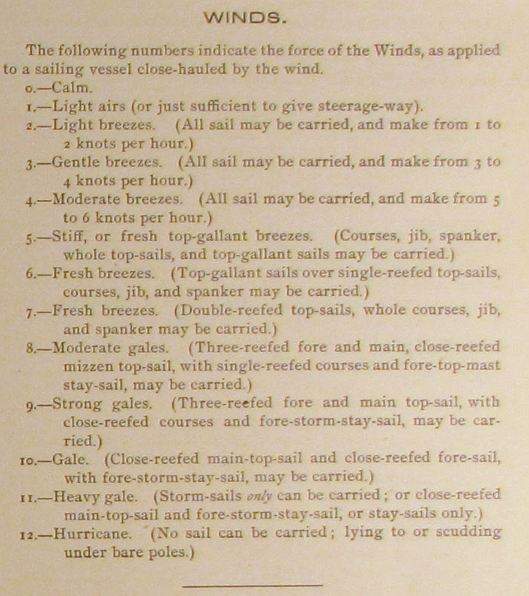
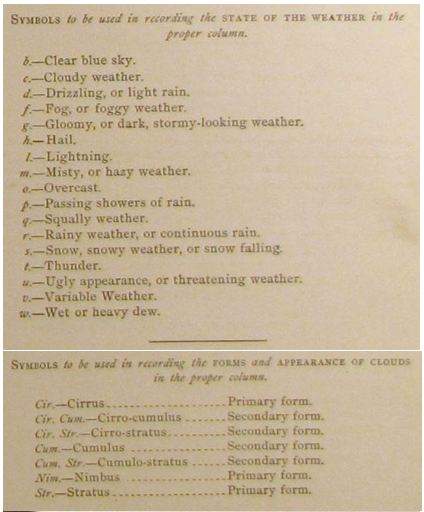
Royal Navy
Logbook 1913
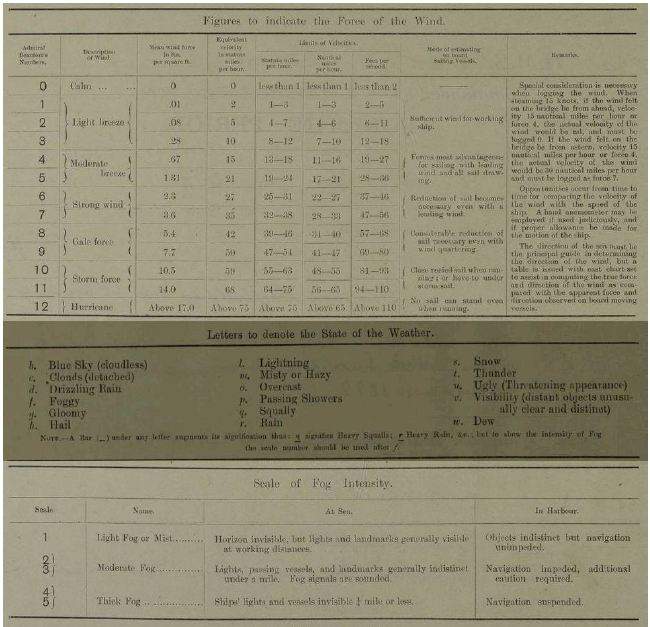
4. Beaufort Wind
Force Scale
With
thanks to Wikipedia and the UK Met Office
Notes: the images are
taken from an ocean-going vessel and represent well
well-developed waves in the open sea. The affect on
smaller vessels in the open sea will be more
pronounced. In more sheltered seas, the same wind
speed will result in smaller waves. Note also that
there is a lag between the increase in wind speed and
the waves increasing in size.
| Beaufort
Number |
Description |
Wind
speed, wave height, sea conditions |
Sea state photo.
|
| 0 |
Calm |
Wind speed less than 1
knot, 1 kph, 1mph.
Sea: like a mirror
|
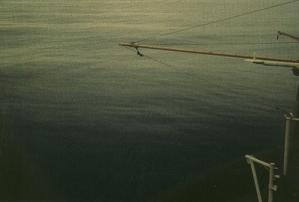 |
| 1 |
Light air |
Wind speed 1-3 knots,
1.1-5.5kph, 1-3mph.
Sea: wave height 10cm, 3in,
ripples with the appearance of scales, but
without foam crests
|
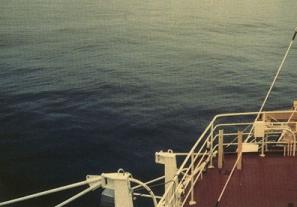 |
| 2 |
Light breeze |
Wind speed 4-6 knots,
5.6-11kph, 4-7mph.
Sea: wave height 20-30cm, 6-12in,
small wavelets, crests have a glassy appearance
and do not break
|
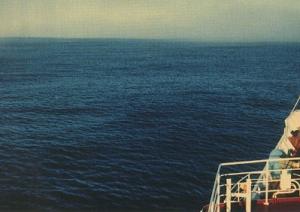 |
| 3 |
Gentle breeze |
Wind speed 7-10 knots,
12-19kph, 8-12mph.
Sea: wave height 60-100cm, 2-3ft,
large wavelets, crests begin to break, any foam
has glassy appearance, scattered whitecaps
|
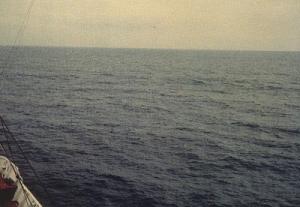 |
| 4 |
Moderate breeze |
Wind speed 11-16
knots, 20-28kph, 13-17mph.
Sea: wave height 1-1.5m, 3.5-5ft,
small waves becoming longer, fairly frequent
white horses
|
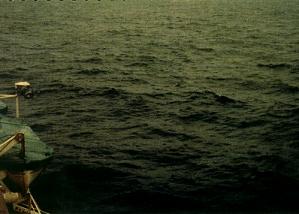 |
| 5 |
Fresh breeze |
Wind speed 17-21
knots, 29-38kph, 18-24mph.
Sea: wave height 2-2.5m, 6-8ft,
moderate waves taking more pronounced long from,
many white horses, chance of some spray
|
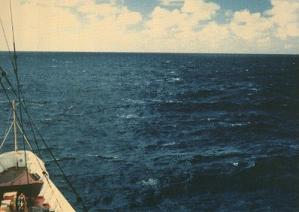 |
| 6 |
Strong breeze |
Wind speed 22-27
knots, 39-49kph, 25-30mph.
Sea: wave height 3-4m, 9.5-13ft,
larger waves begin to form, spray is present,
white foam crests are everywhere
|
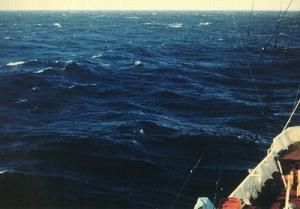 |
| 7 |
High wind, moderate gale, near gale |
Wind speed 28-33
knots, 50-61kph, 31-38mph.
Sea: wave height 4-5.5m,
13.5-19ft, sea heaps up, white foam from
breaking waves begins to be blown in streaks
long the wind direction
|
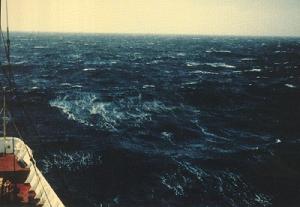 |
| 8 |
Gale, fresh gale |
Wind speed 34-40
knots, 62-74kph, 39-46mph.
Sea: wave height 5.5-7.5m,
18-25ft, moderately high waves of greater
length, edges of crest begin to break into
spindrift, foam blown in well marked streaks
along wind direction
|
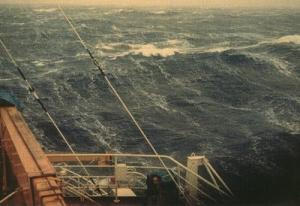 |
| 9 |
Strong gale |
Wind speed 41-47
knots, 75-88kph, 47-54mph.
Sea: wave height 7-10m, 23-32ft,
high waves, dense streaks of foam along
direction of the wind, wave crests begin to
topple, tumble, and roll over, spray may affect
visibility
|
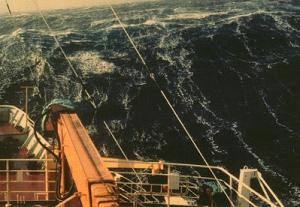 |
| 10 |
Storm, whole gale |
Wind speed 48-55
knots, 89-102kph, 55-63mph.
Sea: wave height 9-12.5m, 29-41ft,
very high waves with long overhanging crests,
the resulting foam, in great patches, is blown
in dense white streaks along wind directions. On
the whole, sea surface takes a white appearance,
tumbling of the sea is heavy and shock-like.
Visibility affected.
|
 |
| 11 |
Violent storm |
Wind speed 56-63
knots, 103-117kph, 64-73mph.
Sea: wave height 11.5-16m,
37-52ft, exceptionally high waves, small-medium
sized ships may be lost to view behind the
waves, sea completely covered with long white
patches of foam lying along wind direction.
Everywhere, the edges of wave crests are blown
into froth.
|
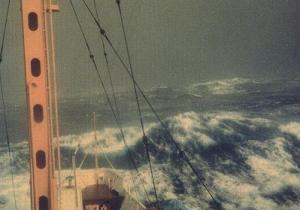 |
| 12 |
Hurricane |
Wind speed greater
than 64 knots, 118kph, 74mph.
Sea: wave height greater than 14m,
46ft, completely white with driving spray,
visibility very seriously affected. The air is
filled with foam and spray
|
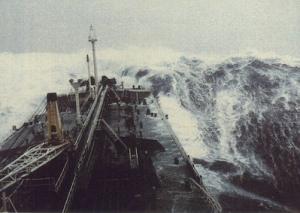 |

5.
Cloud Types
Compiled by
Janet Jaguar
A more organized list:
|
Cirrus
|
Cir/Ci
|
high and wispy
|
|
Nimbus
|
Nim/Ni
|
produces precipitation
|
|
Stratus
|
Str/Strat/St
|
a flat layer of cloud
|
|
Cumulus
|
Cum/Cu
|
puffy pile of cloud
|
|
V clear
|
CAVU
|
ceiling and visibility unlimited
|
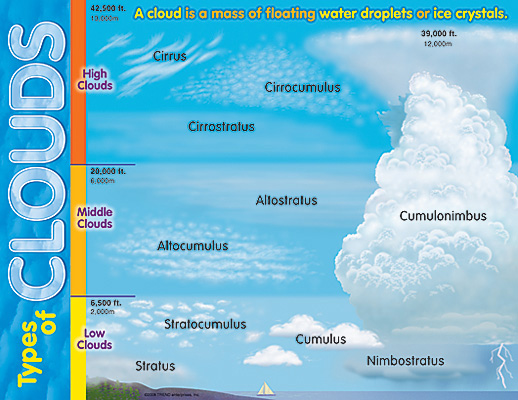
See
also an
excellent poster on this, much more detailed
pictures - too big to embed.
http://www.ec.gc.ca/Publications/643BB615-17E8-4952-B73A-E21373F0B22B/cloud_poster_e.pdf
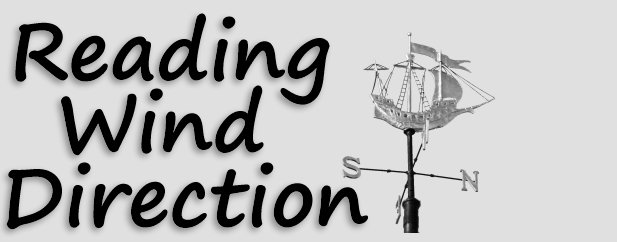
6. Reading Wind direction
and
directions at sea, in general
Compiled by
Janet Jaguar
We are asking everyone to type in the wind direction just as
written, because the more complex writings are not
from our familiar 16 point compass rose. Any wind
directions that are one, two or three capital letters
with no punctuation are from the familiar 16 point
compass rose.
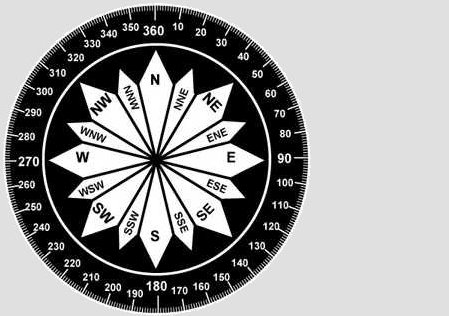
A
picture with better resolution is at
http://en.wikipedia.org/wiki/File:Compass_rose.png
Any wind directions that are punctuated represent the
other directions from the 32 point compass rose. These
may be written as NxE, NbyE, NbE, N'E, or N/E.

A
picture with better resolution is at
http://commons.wikimedia.org/wiki/File:Compass_Card.png
NE is 45 degrees clockwise from due North. NbE (or NxE
or N'E or whatever) is only 11.25 degrees from due
North. This makes a big difference.
Other things also appear in this column, such as
'Calm', 'Nil', 'Light Airs' and 'Variable' that must
be typed out. Things like 'N'ly' or 'N'y' are short
for 'Northerly' which is not from any compass rose,
but something a little more vague. Type it as written
rather than guess what precise direction was actually
happening at the time.
I hope this helps us understand what our original
lieutenants were observing and recording.
ADD-ON: Life and the HMS Torch log-keeper have just
taught me that there is also a 128 Point Compass Rose.
Not that I personally, landlubber that I am, ever will
use this much detail. But if you ever see a wind
direction with fractions in it (N1/2E),
transcribe it as is (N 1/2 E).
Note from Philip Brohan: "One final wrinkle to beware
of - the half and quarter points can each be referred
to by two different names - 'W 1/2 S' is also 'W by S
1/2 W' for example." So Type What You See.
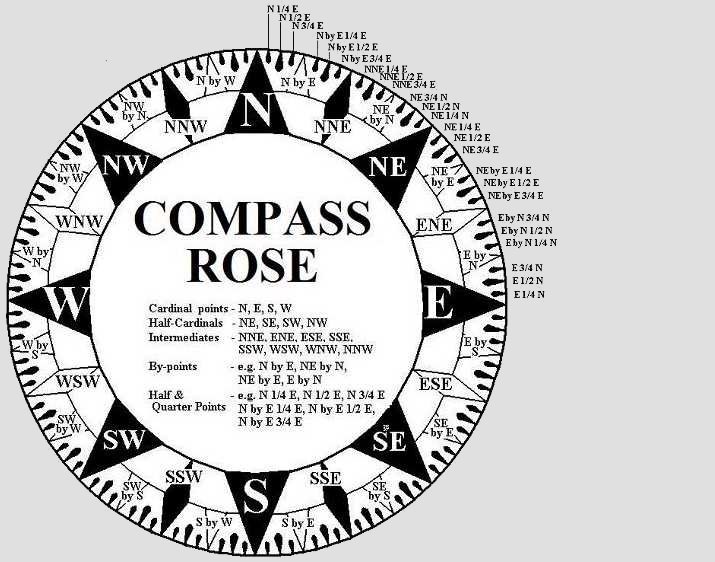
(Above: 128 Point Compass Rose from
Naval-History.net
Ships List.)

Compiled by
Janet Jaguar
7.
SEA ICE TYPES
Taken
from
FORECASTERS HANDBOOK FOR THE ARCTIC,
Appendix A: Glossary and Report
of the cruise of the revenue marine
steamer Corwin in the Arctic Ocean in the Year
1884, supplemented with
other government and Greenpeace images, and a few
additional archaic ice
terms. Some sailing terms are at the end. The resource
links
contain a great many more terms than are listed here.
Click on the
pictures to enlarge them. (Approximate conversions: 16
kilometers = 10
miles; 10 meters = 11 yards.)
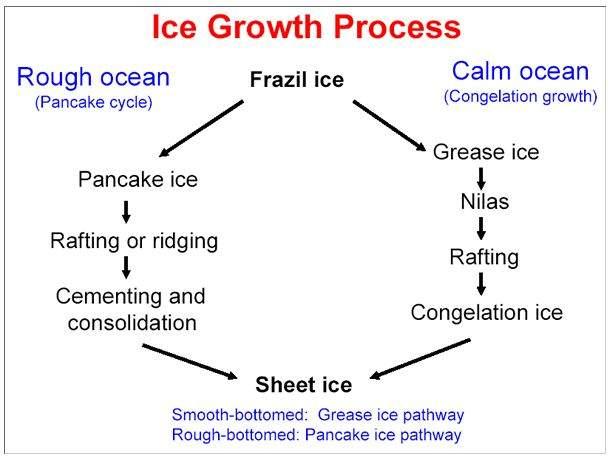
Ice Formation: Sea state affects the way ice is formed
(Source:NSIDC)
| no
picture found |
BAY ICE: An archaic term that
covers the range from nilas to grey. This
was bad for sailing ships as it could stop
them entirely whereas they could force (or
bore) through much heavier floes given wind
and some looseness in the pack. (Kevin
Wood)
|
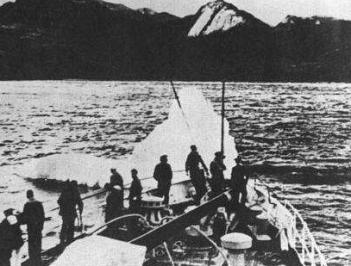 |
BERGY BIT: A large piece of
floating
glacier ice, generally showing less than 16
ft. (5 m) above sea level but more than 3
ft. (1 m)
and normally about 120 to 360 sq.yds.
(100-300 sq.m.) in area.
|
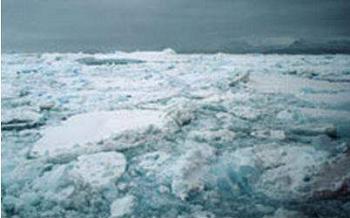 |
BRASH
ICE: Accumulations of
floating ice made up of fragments not
more than 6.5 ft. (2 m) across, the wreckage
of other forms of ice. |
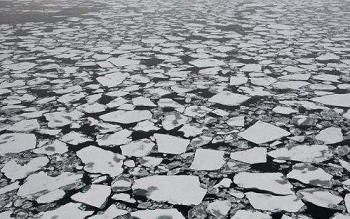 |
BROKEN
ICE: Ice broken up into sharp
pieces. (from old logs and new image
captions) |
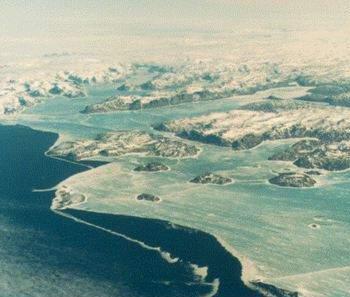 |
FAST
ICE: a.k.a. LAND-FLOE; Sea ice that forms and
remains fast along the coast, where it is
attached to
the shore, to an ice wall, to an ice front,
between shoals or grounded icebergs. Vertical
fluctuations may be observed during changes of
sea
level. Fast ice may be formed on site from sea
water or by freezing of pack ice of
any age to the shore, and it may extend a few
yards (meters) or several hundred
miles (kilometers) from the coast. Fast ice
may
be more than one year old and may then be
prefixed with appropriate age
category (old, second year, or multiyear). If
it is thicker than about
7 ft. (2 m) above sea level, it is called an
ice shelf.
|
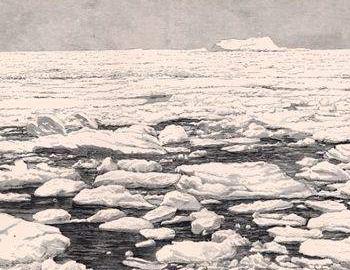 |
FLOE: Any relatively flat,
isolated piece of sea ice 65 ft. (20 m) or
more across. Floes are
subdivided according to horizontal extent as
follows: GIANT: over 6 mi (10 km) VAST: 1-6
mi (2-10
km) BIG: 550-2200 yd. (500-2000 m) MEDIUM:
110-550 yd. (100-500 m) SMALL: 22-110 yd.
(20-100 m) (image - seen from USRC Bear,
1884; also see Melt Pool image)
|
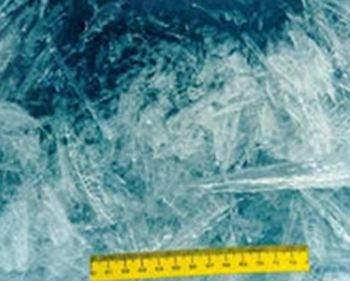 |
FRAZIL
ICE: Fine spicules, or plates of ice,
suspended in water. |
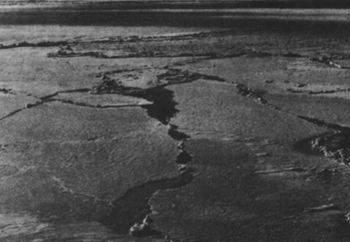 |
GRAY
ICE: Young ice 4 to 6 in (10-15
cm) thick. Less elastic than nilas and breaks
on swell. Usually rafts under pressure. |
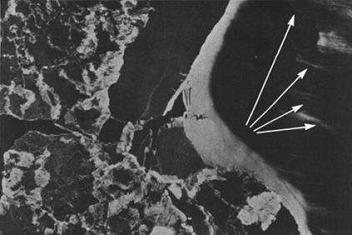 |
GREASE
ICE: A later stage of freezing
than frazil ice. It occurs when the crystals
have coagulated to form a
soupy layer on the surface. Grease ice
reflects little light, giving
the sea a matte appearance (image - Grease
ice on right, Nilas to left) |
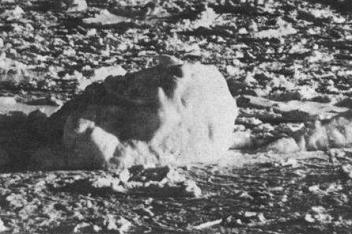 |
GROWLER: Smaller piece of
ice than a bergy bit, often transparent but
appearing green or almost black in color.
Usually extends less than 3 ft. (1 m) above
the sea surface and normally occupies an
area of about 24 sq.yd. (20 sq.m)
|
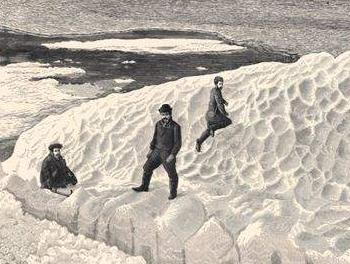 |
HUMMOCK:
A hillock of broken ice
that has been forced upwards by pressure. May
be fresh or weathered. The submerged volume of
broken ice under the hummock, forced downwards
by pressure, is termed a hummock. HUMMOCKY ICE
is rough, uneven ice. (image - crew of
USRC Bear, 1884) |
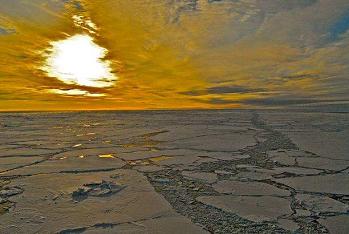 |
ICE BLINK: A peculiar pale
yellow
reflection on the sky and indicates the
presence of ice at a distance.
|
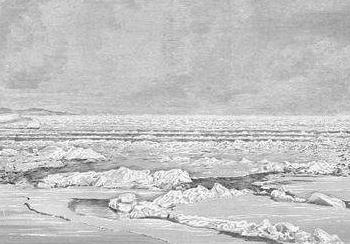 |
ICE FIELD: Area of pack ice
consisting of
floes of any size that is greater than 6
miles (10 km) wide. (image - see by USRC
Bear, 1884)
|
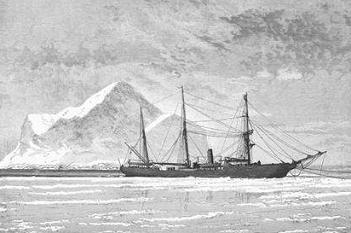 |
ICEBERG: A massive piece of
ice of greatly varying shape, more than 16
ft. (5 m) above sea level, which has broken
away from a glacier, and which may be afloat
or aground. Icebergs may be
described as tabular, dome-shaped, sloping,
pinnacled, weathered, or glacier bergs.
(image - with USRC Bear, 1884)
|
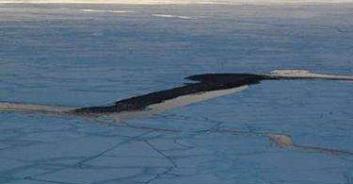 |
LEAD: Any fracture or
passageway through sea ice that is navigable
by surface vessels. (image - lead or
crack, USGS)
|
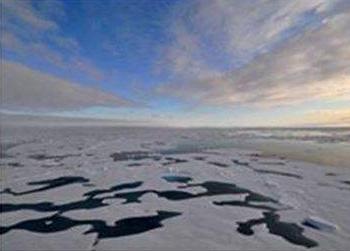 |
MELT POOL/POND: Melt ponds are
pools of
open water that form on sea ice in the
warmer months of spring and summer.
The ponds are also found on glacial ice and
ice shelfs. Ponds of melted water
can also develop under the ice. (Wiki)
(image - ice floes, melt pools, and polyna
on right)
|
| no
picture found |
NEW ICE: A general term for
recently formed ice that includes frazil
ice, grease ice, slush, and shuga. These
types of ice are composed of
ice crystals that are only weakly frozen
together (if at all) and have a definite
form only while they are afloat.
|
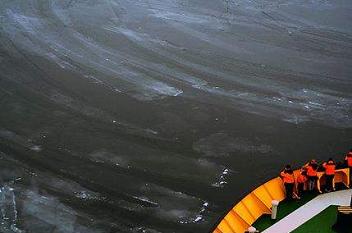 |
NILAS:
A thin, elastic crust of ice bending easily on
waves and swell. Nilas has a matte surface and
is
up to 4 in (10 cm) thick. Under pressure it
thrusts into a pattern of
interlocking fingers (see FINGER-RAFTED ICE).
May be subdivided into dark nilas and light
nilas.
(image - see also Grease Ice image) |
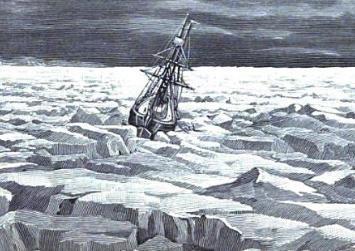 |
NIPPING
ICE: Ice is said to be nipping
when it begins to close by reason of the
action of winds or currents so as to
prevent the passage of a vessel. (image -
USRC Corwin in a nip) |
 |
OLD ICE: Sea ice that has
survived at least one summer's melt. Most
topographic features on old ice are smoother
than those on first-year ice. May be
subdivided into second-year ice and
multi-year ice. (image - multi-year ice)
|
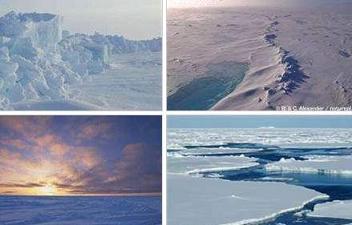 |
PACK
ICE: a.k.a. ICE PACK. Term used in a wide
sense to include any area of sea ice, other
than fast ice, no matter what form it takes or
how it is disposed.
|
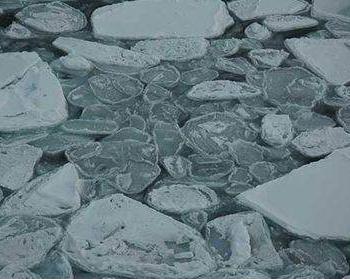 |
PACKED ICE: Small pieces
closed together and held by the pressure of
wind and currents. (image - Pancake Ice
in centre. US Army Cold Regions Research
and Engineering Laboratory)
|
 |
PANCAKE ICE: Predominantly
circular pieces of ice from 1 to 10
ft. (30 cm to 3 m) in diameter and up to
about 4 in
(10 cm) in thickness, with raised rims due
to
the pieces striking against one another. It
may be formed on a slight swell from grease
ice, shuga, or slush, or as a result of the
breaking of ice rind, nilas, or, under
severe conditions of swell or waves, of gray
ice. Sometimes pancake ice forms at some
depth, at an interface between water bodies
of different physical characteristics, from
where it floats to the surface; it may cover
wide areas of water rapidly.
|
 |
POLYNYA:
Any nonlinear-shaped
opening in the water but enclosed by ice.
Sometimes the polynya is limited on one side
by the coast and is called a shore polynya, or
by fast
ice and is called a flaw polynya. Some polynyi
recur annually in the same position. (image
- see also Melt Pool image) |
| no
picture found |
PORRIDGE:
Small finely ground-up ice. YOUNG PORRIDGE is
porridge ice just forming. (See Brash, Slush
and Young Ice.)
|
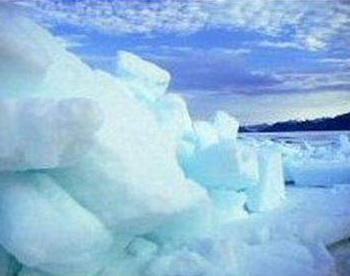 |
RIDGE:
A line or wall of broken ice forced up by
pressure; it may be fresh or weathered. The
submerged volume of broken ice under a ridge,
forced downwards by pressure, is termed an ice
keel. |
| no
picture found |
ROTTEN ICE: Sea ice that has
become honeycombed and is in an advanced
state of disintegration.
|
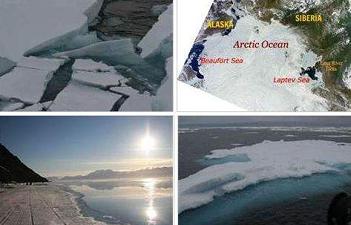 |
SEA
ICE: Any form of ice found at sea
that has originated from the freezing of sea
water. |
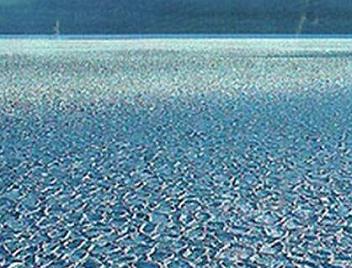 |
SHUGA:
An accumulation of
spongy white ice lumps, a few inches
(centimeters) across; they are formed from
grease ice or slush and sometimes from ice
rising to the surface. |
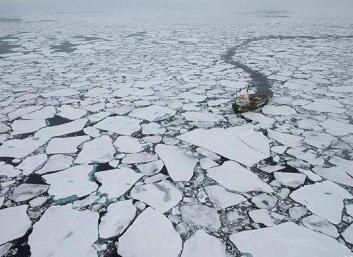 |
SLACK ICE: Ice that is
detached so
that it can be worked through. Ice is said
to be SLACKING when it begins to open so as
to be navigable.
|
| no
picture found |
SLUSH: Snow that is saturated
and mixed with water on land or ice
surfaces, or as a viscous
floating mass in water after a heavy
snowfall.
|
| no
picture found |
YOUNG
ICE: Ice in the transition stage between nilas
and first-year ice, 4 to 12 in (10-30 cm) in
thickness. May be subdivided into gray ice and
gray-white ice. |
| |
|
|
SAILING
TERMS
|
| |
|
|
BUCKING: Backing off and
ramming ice in order to break a way through
it. |
|
TRACKING: Following along
the
edge of the ice pack. |
|
WAKING: Following of
another vessel through leads and slack ice |

Compiled by DJ_59
8.
External Links to Royal Navy, World War 1-era
(See
also list of links compiled for Old Weather Phase 3)
Here are some links that may help you with everything
from locations to historic context. The addresses are
embedded in the titles, so just click on the blue text.
THE SHIPS
Clydebuilt
Ships Database
- Complete
data with some pictures of 200 years of ships built on
the River Clyde,
merchant and naval.
Haze
Gray & Underway Search Engine
- Another
search engine for looking up info about ships. At the
time this links
page was under construction, so use the substitute
search engine under the main
one.
Historic Naval
Ships
Association - Huge amount of
information about all things Navy,
from broad overviews to things as specific as
explanations of the hydraulic
catapults in Essex class carriers. Sound fun? Wanna see
the manual? No kidding, all the manuals to every little
thing are on this site. Endlessly fascinating site.
Lloyd's Register Of Ships - Here you
will find the registration details of a vessel such as
the rigging, the
tonnage, dimensions, propulsion, owners and her Master.
These have been
transcribed from the Lloyd's Register of British and
Foreign Shipping from 1764
up to 2003, by Gilbert Provost with assistance from
Pauline Joicey.
Mid-Victorian Royal Navy - Excellent
catch-all
site with info about ships, officers and more.
Naval-History.net List of our RN transcribed fleet - All
the ships we have finished transcribing and are now
actively editing.
Royal Navy Log
Books of the
World War 1 Era - An Old Weather Citizen History
Project - All
of our edited RN logs, and those waiting to be edited.
Old Ship Picture
Galleries - An
enormous database of pictures. You can probably find
yours here.
Probert Encyclopedia - Ships - Another
place to find information on your ships.
Roll of Honour - List of the many naval and
merchant ships lost during the war, including the German
ships interned at
Scapa Flow. They ask that users of their data and
pictures always credit
them as the source.
Royal
Fleet Auxiliary -
List
of Royal Fleet Auxiliary ship names
Ship Index Org -
Tells
you which books, magazines, and online resources mention
the vessels you're
researching. With 142,804 entries in the free database
and 1,515,323 entries
available with premium access, you're bound to find
useful information here.
The Ships List -
There
were a great many companies involved in the ocean trade.
The Ships List
attempts to collect the names of the companies and
present a brief history of
each and the names of the vessels they used.
Ship Names of
the Royal Navy
(Wikipedia) - A listing of the
correct spelling of the names of
the more than 13,000 ships that have ever served in the
Royal Navy, with links
to the articles on individual ships when they exist.
WreckSite - If your ship now resides
on the ocean floor, chances are there's information
about it right here.
CODES AND OTHER
ABBREVIATIONS
Abbrevations
used in the World
War One Medal Cards - Large list
of abbreviations used in all
branches of U.K. and other militaries.
Abbreviations
(General U.K.
military) -
Large list of abbreviations used in
all branches of
U.K. military.
Signal Flags - An explanation of how
these were used, and the code indicated by the "Signal
Book Correct"
phrase/abbreviation in the logs.
Weather Codes -
B?
C? BC? Huh? Here's a chart that explains all the
Beaufort weather codes
you see every day on Old Weather's ship's logs!
Weather Codes
(again) - This
is an image of a log book page with weather codes
explained. Not as
complete as the Beaufort Codes page elsewhere in these
links, but nice to see.
LIGHTHOUSES
Amateur Radio
Lighthouse
Society - ARLHS World List of
Lights (WLOL).
Brazilian Lighthouses - Extensive site
with links to (you guessed it) Brazilian lighthouses.
The Lighthouse Directory - Provides
information and links for more than 13,300 of the
world's lighthouses.
Lighthouse Depot
- A
good search engine for lighthouses; no location
information included, but
searching for keywords "Gozo Light", for example, will
tell you
"Giordan Light" is on Gozo Island, Malta.
American
practical navigator:
an epitome of navigation and nautical astronomy
1916 - Section 1
Appendix IV lists just about every port and lighthouse
in the world by
Lat.Long. location, alphabetical index at the end. The
rest of the book
teaches everything anyone might want to know about
navigation.
Lighthouses of China: Hong Kong - If
you need info on lighthouses in Hong Kong Harbor, this
is the link for you.
FINDING LOCATIONS AND
OBJECTS
David Rumsey Map
Collection - An
enormous archive of maps both current and archaic.
Fuzzy Gazetteer - Outstanding resource
where you can plug in that place name you can't quite
read all the letters of,
and it will come back with potentially correct names
Geographical Names - National
Geospatial-Intelligence Agency, Bethesda, MD, USA. They
offer alphabetical
lookup of places. If you're trying to figure out just
what it says in the
location box on a log sheet, this site might help.
Google Maps - Quickly
become
the standard.
Probert
Encyclopedia - Archaic
Maps - Maps of the world at
different points in time. Borders change, country names
change. Something mentioned in a log from
1916 may not make sense when looking at today's maps, so
this is quite helpful.
Wuvulu
Website - The Western Islands of the Bismarck
Archipelago -
A comprehensive, annotated index of
current and
historical names of all the islands in the Western
Islands of the Bismarck
Archipelago as well as other indexes and relevant
information necessary to
conduct bibliographic, historical and general research
regarding the Western
Islands.
American
practical navigator:
an epitome of navigation and nautical astronomy
1916 - See
description in Lighthouses, above.
Asiatic Pilot,
African Pilot,
British Isles Pilot, etc. 1915 to 1925 - Detailed
description of
landmarks and English names for every coast in the world
by the United States
Hydrographic Office. Superb name finder, with them
listed in the order the ship
sails past them.
Names
of places on the China
coast and the Yangtze River 1904 -
by order of the Shanghai
Inspector General of Customs, listing names in English
and Chinese and the
customs district, prefecture and sub-prefecture it
belongs to.
Handbook
to the West River 1904
-
A Hong Kong tourist brochure
pushing vacation cruises,
complete with place names, pictures and a full size map!
HISTORICAL BACKGROUND
& RESEARCH TOOLS
Articles of War - The 1866 version of the
"Articles of War" read to the sailors on all of our
ships. The
1884 version does not seem to be digitized, but a
listing of the changes made
through 1884 (the version our sailors heard) can be
found at
Legislation
concerning. The earlier version of
1757 with its more draconian punishments can be found
at this link.
Britain At War Magazine
- A nicely
done online magazine with plenty of historical info and
interesting articles.
Chinese History
by Geography -
A site of short summaries of the
history of many cities and
areas within China.
FirstWorldWar.com - An overview of the
Great War.
Kings
Regulations &
Admiralty Instructions - All the
rules, regs and procedures that
the officers and men of the Royal Navy lived by. This
site can help you
make sense of things written in the events column.
National
Archives (U.K.) - A
good resource for research.
Naval-History.net
- Nearly
everything you would ever want to known about the
histories of various Navies
in several wars. Everything from casualty lists to war
diaries to
in-depth info about the ships and men. And it's run by
one of Old
Weather's science team members, Gordon Smith (with great
assists from Don Kindall, our own Kin47!)
Sections
that might be helpful to
editors:
NavHist - Naval
History
via Flix. A listing of ships and everything attached to
them.
New York Times Archive 1851-1980 - Cost-prohibitive,
but very useful if you are inclined to shell out the
bucks.
PapersPast - A
newspaper search engine.
Pathe Newsreels
- You've
seen 'em on TV, now you can access them Online and even
search for newsreels
covering specific topics. Warning: it's very easy to get
lost for hours
watching these!
Royal Navy - All
kinds
of sub-links from this, including one to "History",
where you
can choose different eras, including 1914-1939.
WWI - The War At Sea - A section of
the WWI/WWW which provides resources for doing historic
research on the naval
side of the conflict.
WEATHER-SPECIFIC
SITES
Amateur Hobbyist Weather Sites - This
is a link to links, basically. Here you'll find links to
a small stack of ameteur weather observation websites.
Cloud
Observers -
Here's
their Mission Statement: 'To keep the Meteorological
Observers Branch alive and
to foster good relations with members young and old. To
establish and promote
links with other Fleet Air Arm Branches.'
MARINE
OBSERVATIONS OF OLD
WEATHER - Published results from
OldWeather's predecessor.
MISCELLANY
Reaumur temperature conversion - Link
to a Wikipedia page about Reaumur scale with conversion
table between different
temperature measure units and Reaumur temperature
conversion forumlae.
Boxing the
Compass - Boxing
the compass is the action of naming all thirty-two
principal points of the
compass in clockwise order. Such names, formed by the
initials of the cardinal
directions and their intermediate ordinal directions,
are accepted
internationally, even though they have their origin in
the English language,
and are very handy to refer to a heading (or course or
azimuth) in a general or
colloquial fashion, without having to resort to
computing or recalling degrees.
The Navy
Everywhere - This
e-book, The Navy Everywhere by Conrad Gato, gives good
details of naval opps
throughout WWI. Written in 1919.
Rigging
For Landlubbers -
Interesting
site that explains the specifics of various methods of
rigging a ship, from
Halyards to Shrouds, Backstays to Leechlines.
NAVY
MANUALS AND DOCUMENTS ONLINE (Historic Naval Ships
Association)
- Many how-to books and
documents printed by navies
for their officers to use, ranging from the "Textbook of
Seamanship"
1891 to Gunnery and Foundry manuals to WWII
submarines.
9.
External Links to US Navy, Revenue Service/Coast
Guard and Coast & Geodetic Service in the 19th
and 20th centuries
(See
also list of links compiled for Old Weather Phase
1/2)
Here
are some links that may help you with everything from
locations to historic context. The addresses are
embedded in the titles, so just click on the blue text.
THE SHIPS
OUR OW SHIPS,
the Lists of Naval-History.net:
Arctic
Rediscovery:
Coast Guard Image Gallery - This
digital image library and
on-line exhibit is from photographs taken by the crews
of US Revenue Marine and
Coast Guard cutters. In addition to showing what the
environment looked like at
specific times and places, these pictures also reveal
fascinating details of
daily life on the cutters.
Cutters,
Craft & U.S. Coast Guard-Manned Army &
Navy Vessels
-
This is a
list of named vessels of the Revenue Marine, Revenue
Cutter Service, Coast
Guard and Lighthouse Service. The Historian's Office
maintains a file on
most of the vessels. Click here to see
available online pictures.
DANFS:
Dictionary of American Naval
Fighting Ships
- Part
of the Naval History & Heritage Command, this
indexes everything fighting
and American, including Confederate Forces Afloat.
Historic
Naval Ships Association
- Huge amount of information about
all things Navy, from
broad overviews to things as specific as explanations of
the hydraulic
catapults in Essex class carriers. Sound fun? Wanna see
the manual? No kidding, all the manuals to every little
thing are on this site. Endlessly fascinating site.
Lloyd's Register
Of Ships
-
Here you
will find the registration details of a vessel such as
the rigging, the
tonnage, dimensions, propulsion, owners and her Master.
These have been
transcribed from the Lloyd's Register of British and
Foreign Shipping from 1764
up to 2003, by Gilbert Provost with assistance from
Pauline Joicey.
Naval History
&
Heritage Command (USN) Photographic Gallery
-
The Online Library is the
Photographic Section's readily accessible index to Naval
and maritime history
pictures. To the best of their knowledge, all Online
Library pictures are in
the public domain and can therefore be freely downloaded
and used for any
purpose without requesting permission. (Their Coast
Guard section is much
smaller than the USGC's history sections, but the naval
sections are immense if
you are interested.)
NOAA: Coast and
Geodetic
Survey ships
-
The
major contribution of these small ships has been through
their devotion to
accuracy and precision in the charting of our Nation?s
waterways.
Old Ship
Picture Galleries
- An enormous database of
pictures. You can probably find yours
here.
Ship Index
Org
- Tells
you which books, magazines, and online resources mention
the vessels you're
researching. With 142,804 entries in the free database
and 1,515,323 entries
available with premium access, you're bound to find
useful information here.
The Ships
List
-
There
were a great many companies involved in the ocean trade.
The Ships List attempts
to collect the names of the companies and present a
brief history of each and
the names of the vessels they used.
Ship Names of
the United States Navy (Wikipedia) - A listing of the correct spelling of the
names of the thousands of ships that have ever been
registered in the US Navy,
with links to the articles on individual ships when they
exist.
Whaling and
Sealing Ships
-
A limited
list of whaling and sealing ships. The Dundee Whaling
fleet participated
in the Arctic Whale and seal hunting for longer than
many other countries.
WreckSite -
If your ship
now resides on the ocean floor, chances are there's
information about it right
here.
CODES AND OTHER
ABBREVIATIONS
A military
and naval dictionary (1905)
-
Large list of abbreviations used in
all branches of US
military.
Naval-History.net
List of
US Navy Ranks
- Commissioned
Officers - Enlisted Rates - Enlisted Branches and
Definitions - Enlisted Rank
abbreviations - Yeoman (F).
Signal Flags
- An
explanation of how these were used, and the code
indicated by the "Signal
Book Correct" phrase/abbreviation in the logs. See also
this list.
Weather Code
Chart
-
(one of our own reference posts) What do those
direction letters mean and just how complicated can they
get? The abbreviated charts printed in the logbooks is
added. (Log keepers have
been known to use codes from the expanded list.)
LIGHTHOUSES
Amateur Radio
Lighthouse Society
- ARLHS World List of Lights
(WLOL).
American
practical navigator: an epitome of navigation and
nautical astronomy 1916
- Section 1
Appendix IV lists just about every port and lighthouse
in the world by Lat.Long.
location, alphabetical index at the end. The rest of the
book teaches
everything anyone might want to know about navigation.
The Lighthouse
Directory
- Provides
information and links for more than 13,300 of the
world's lighthouses.
Lighthouse
Depot
-
A
good search engine for lighthouses; no location
information included, but
searching for keywords "Gozo Light", for example, will
tell you
"Giordan Light" is on Gozo Island, Malta.
FINDING LOCATIONS AND
OBJECTS
Asiatic
Pilot, African Pilot, British Isles Pilot, etc.
1915 to 1925
- Detailed
description of landmarks and English names for every
coast in the world by the
United States Hydrographic Office. Superb name finder,
with them listed in the
order the ship sails past them.
David Rumsey
Map Collection
- An
enormous archive of maps both current and archaic. This
arctic map (1929) and this
map of Alaska (1924) are some of the best.
Fuzzy Gazetteer
- Outstanding
resource where you can plug in that place name you can't
quite read all the
letters of, and it will come back with potentially
correct names
Geographical
Names
- National
Geospatial-Intelligence Agency, Bethesda, MD, USA. They
offer
alphabetical lookup of places. If you're trying to
figure out just what
it says in the location box on a log sheet, this site
might help.
Google Maps
- Quickly
become the standard.
NOAA Alaskan
coastal charts
-
Historic
ship charts with detailed coastal names. This
NOAA Aleutian
Islands coastal chart
has to be the best yet for the Aleutian
Islands.
OfFICERS and
PERSONNEL
Officers of
the Continental and U.S. Navy and Marine Corps,
1775-1900
- A complete
alphabetical list of all commissioned officers who
served in the Continental
Navy and Marines (1775-1785) and the US Navy and Marines
(1798-1900). (From 1786-1797, the nation did not have a
navy or marine corps.)
US Revenue
Cutter Service Historical Register of Officers
1790-1914
- A complete
alphabetical list of all commissioned officers who
served in the USRCS from its
founding to its merger with the Life-saving Service to
form the current US
Coast Guard.
World War 1 at
Sea:
UNITED STATES NAVY, COAST GUARD & MARINE CORPS
CASUALTIES
- Killed and Died
- A complete
list provided by our Naval-History.net.
HISTORICAL BACKGROUND
& RESEARCH TOOLS
American
practical navigator: an epitome of navigation and
nautical astronomy 1916
- The book
teaches everything anyone might want to know about
navigation.
Arctic
Rediscovery: A Look Back - Gallery - Photos reveal fascinating details of
life on historical ships in the Bering Sea ? Arctic
region beginning in the
mid-19th century. The photos augment the data being
recovered from the ships
logs.
FirstWorldWar.com
- An overview
of the Great War.
Naval-History.net
- Nearly
everything you would ever want to known about the
histories of various Navies
in several wars. Everything from casualty lists to war
diaries to
in-depth info about the ships and men. And it's run by
one of Old
Weather's science team members, Gordon Smith (with great
assists from Don Kindall, our own Kin47!)
NavHist
-
Naval
History via Flix. A listing of ships and everything
attached to them.
Navy
Department Library Online Reading Room - The full library of all online books,
documents and photos that belong to the US Navy.
NAVY MANUALS AND
DOCUMENTS ONLINE
(Historic Naval Ships Association)
-
Many how-to books and documents printed by navies for
their officers to use, ranging from the "Textbook of
Seamanship" 1891 to Gunnery and Foundry manuals to WWII
submarines.
New York Times
Archive 1851-1980
- Cost-prohibitive,
but very useful if you are inclined to shell out the
bucks.
NOAA Photo
Library
-
Built as to capture the work, observations, and studies
that of the scientists, engineers, commissioned
officers, and administrative personnel that make up this
complex and scientifically diverse agency.
PapersPast
-
A newspaper search engine.
Pathe
Newsreels
- You've
seen 'em on TV, now you can access them Online and even
search for newsreels
covering specific topics. Warning: it's very easy to get
lost for hours
watching these!
Textbook of
Seamanship 1891
-
The
equipping and handling of vessels under sail or steam
for the use of the United
States Naval Academy. Good for newbie sailors.
U.S. Coast
and Geodetic Survey Annual Reports - This site provides access to the annual
reports to congress of the Coast and Geodetic Survey
from 1837 to 1965 in PDF
format. Use the alphabetic index in each to find the
report on your
vessel that year.
WWI - The War At
Sea
- A section of
the WWI/WWII which provides resources for doing historic
research on the naval
side of the conflict.
1911
Classic Encyclopedia - based on
what many consider to be the
best encyclopedia ever written: the eleventh edition of
the Encyclopedia
Britannica, first published in 1911. They are using
crowd-sourcing to
correct and update the scans of the 1911 Encyclopedia
Britannica and its 1922
supplemental material.
WEATHER-SPECIFIC
SITES
Amateur Hobbyist
Weather Sites
- This is a
link to links, basically. Here you'll find links to a
small stack of ameteur weather observation websites.
Cloud
Observers
-
Here's
their Mission Statement: 'To keep the Meteorological
Observers Branch alive and
to foster good relations with members young and old. To
establish and promote
links with other Fleet Air Arm Branches.'
MARINE
OBSERVATIONS OF OLD WEATHER
-
Published results from OldWeather's
predecessor.
NOAA
Pictorial Definitions of Types of Sea Ice - Pages 10-12 have many images of
different kinds of sea ice (and icebergs). Also some
pictures of other ships
mentioned, like the whalers Aurora and Arctic. All from
Schley, Report of the Greely Relief Expedition
(Bear, Thetis, Alert 1884).
US Navy
Glossary of Sea Ice Terms
- The following text and photos
are adapted from Sea Ice Nomenclature, WMO No. 259, TP
145.
MISCELLANY
Boxing the
Compass
- Boxing
the compass is the action of naming all thirty-two
principal points of the
compass in clockwise order. Such names, formed by the
initials of the cardinal
directions and their intermediate ordinal directions,
are accepted
internationally, even though they have their origin in
the English language, and
are very handy to refer to a heading (or course or
azimuth) in a general or
colloquial fashion, without having to resort to
computing or recalling degrees.
Glossary of
Naval Architecture Terminologies & Definitions
(Concise Edition)
- a.k.a. parts
for building ships.
Calculate the
day of a year, date validity
-
Your log keeper gave you the day of
the
week, but you think his year is wrong? Check that out
here.
Reaumur
temperature conversion
- Link to a
Wikipedia page about Reaumur scale with conversion table
between different
temperature measure units and Reaumur temperature
conversion formulae.
Rigging For
Landlubbers
- Interesting
site that explains the specifics of various methods of
rigging a ship, from
Halyards to Shrouds, Backstays to Leechlines.
10. OWPEDIA
Compiled by Randi
This is a collection of quotes from various topics
explaining some naval terms.
I have tried to put them in alphabetical order, but the
choice of the word to
use was not always obvious. Items where alphabetic order
didn't make sense are
at the end.
Airing of bedding - Their bedding
was taken to an open deck and draped across lines, etc
to air. Imagine
what sweat, condensation would do to your bed? [kin47]
Always done to discharge Ammunition
before docking. This is then taken to a specific wharf
for storage right away
from the main port area if possible. [dorbel]
Two Anchors is always preferable if
there is likely to be a blow or if the holding ( the
state of the sea bed)
isn't good. It takes longer to weigh of course, so you
will see "at single
anchor" when your vessel is making a short visit or is
required to put to
sea at short notice.
[AND]
It is actually the weight and drag of the anchor chain
(or cable) lying on the
sea bed that keeps the ship where it is. The flukes of
the anchor do dig in of
course but once the cable is veered out, the strain on
the anchor itself should
be minimal or non-existent.
[AND]
A careful skipper will always take bearings on two or
more points when
anchoring in any bay, enabling the officer of the watch
to see at a glance if
she is dragging her anchor. [dorbel]
[AND]
I found a reference to sorting out cats, fish and
capstans (can't quite recall
where - sorry!) the other day. Finally looked this up:
refers to hauling up
anchors. The 'cat' is the cathead, and the 'fish' the
fish-davit. Found these
articles (first short, second leeeeeengthy).
http://www.1902encyclopedia.com/A/ANC/anchor-05.html,
http://www.hnsa.org/doc/luce/part5.htm [AvastMH]
The Armed merchant cruisers' crews
in WW I were mostly Mercantile Marine Reserve, civilians
under military
discipline. The officers were Merchant sailors with RNR
commissions. As a whole, you are only going to find a
few sailors, telegraphists, and
signalmen from the Regular Navy in converted merchant
ships. [kin47 - Don]
Compulsory for the Captain to read the Articles
of War to his Ship's Company at least once a
month. These are the
regulations by which the ship is governed and cover the
offences with which a
seaman may be charged and the penalties thereto. Usually
read on a Sunday at
divisions. [dorbel]
[AND]
The 1866 version of the "Articles of War" read to the
sailors on all
of our ships:
http://www.pdavis.nl/NDA1866.htm
The 1884 version does not seem to be digitized, but a
listing of the changes
made through 1884 (the version our sailors heard) can be
found at:
http://www.pdavis.nl/NDA.htm
The earlier version of 1757 with its more draconian
punishments:
http://www.hmsrichmond.org/rnarticles.htm [Janet
Jaguar]
Badgemen: Sailors of the Royal Navy
with good conduct badges.
http://www.eurekaencyclopedia.com/index.php/Category:Non-Commissioned_Ranks
[Caro]
. they did Take the barometer down
(and presumably pack it in a padded case) during
practice firing on some ships.
[dorbel]
Base ships were floating barracks,
offices, store ships, etc, etc. You see a base ship
usually in the
circumstance where the shore command has outgrown its
space and needs more
room. I.E. about any of the major naval commands. [kin47]
A Battleship is a large armored
warship with a main battery consisting of heavy caliber
guns. Battleships were
larger, better armed and armored than cruisers and
destroyers. As the largest
armed ships in a fleet, battleships were used to attain
command of the sea and
represented the apex of a nation's naval power from the
19th century up until
World War II. With the rise of air power and guided
missiles, large guns were
no longer deemed necessary to establish naval
superiority, and as a result
there are no battleships in active service today.The
word battleship was
coined around 1794 and is a contraction of the phrase
line-of-battle ship, the
dominant wooden warship during the Age of Sail.
http://en.wikipedia.org/wiki/Battleship [Janet
Jaguar]
Beating See Tacking and Beating
After a sighted Bearing is noted, we
sometimes (and should always) see (M), (T) or (S) after
the bearing. Sometimes
the letter is lower case and I don't think that that
matters. (M) is short for
magnetic and indicates that the bearing is with
reference to Magnetic North and
is the uncorrected bearing straight off the pelorus. (T)
is short for True and indicates that the bearing is with
reference to True North. The
navigating officer has corrected the bearing and laid it
off on the chart. More
rarely though we see (S) and this one I don't know. [dorbel]
'Beckets', or rope handles (see
http://www.frayedknotarts.com/beckets.html).
[Steeleye]
I remember a time in my life when Beef
was the usual for Sunday lunch and chicken was a
once-a-year Christmas dinner
treat. - Same back then.[navalhistory]
"Belum" is a kind of
Mesopotamian river boat (various spellings).
http://www.gutenberg.org/files/24893/24893-h/24893-h.htm#Page_99
[Janet Jaguar
/ edited]
Bend - Verb: To fasten, as one rope
to another, a sail to its yard or stay, or a cable to
the ring of an anchor.
Noun: A knot by which one rope is fastened to another or
to some object. [randi_2]
Bight - The double part of a rope
when bent; that is, a round, bend, or coil not including
the ends; a loop. [randi_2]
Blacking down aloft - It is blacking
for the standing rigging, whether of wire or rope and it
is done mainly for
smartness before entering a harbour. I have never
enquired what it is actually
made of but I suspect it is very like stove black,
graphite and carbon in a
paste, which dries to a nice dull sheen.
The Royal Navy, a deeply conservative organisation, has
always been fanatical
about cleanliness, partly for smartness, partly for
hygiene but most of all to
keep a large crew occupied! They have to do something
every day, so they may as
well keep the ship clean. [dorbel]
"Blocks" - supporting the
ship clear of the bottom of the dock to allow access to
the whole underside,
except where the bits where the blocks were in contact
with the hull. [Bunting
Tosser]
Any reference to Boat masts and/or
sails definitely means the cutters, pinnaces etc. Boats
are things that are
hoisted onboard ships. Confusingly sailors (and
particularly submariners) often
refer to their ship as "The boat", although not I fancy
in the log. [dorbel]
Boat pulling is just rowing by
another name. [dorbel]
Bower anchor - An anchor carried at
the bow. (In 1928 dictionary: A bower anchor for a
modern battle-ship weighs a
much as 18,000 pounds; kedges vary from 100 to 900
pounds.) [randi_2]
The Boys are what we would now call
junior seamen, early teens. I think at this time they
took them from 12 years
old and they would indeed have school and a ship of this
size [HMS Yarmouth]
would have a schoolmaster in her complement. [dorbel]
[AND]
At the time of WW1, Boys could be taken on as young as
14. Don't forget the
school leaving age in the UK was that until some years
after WW2. Also the
youngest Victoria Cross winner was Boy Cornwall at the
Battle of Jutland. He
was just 15 and a national hero.
Contrary to all our fears for youngsters these days, I
get the impression they
were well cared for - tough and strictly disciplined
yes, but fairly, and
probably free, in all but the most exceptional cases of
real abuse. I posted a
link in one of the forum about naval court martials in
the First World War. I
don't recollect seeing any cases of Boys being abused.
If anyone finds evidence to the contrary, I'd like to
know about it.
[navalhistory]
The biscuit Breaker has fallen out
of the boat. This is a small sealed barrel full of
ship's biscuit, permanently
stowed in the sea boat in case of emergency. There will
also be at least one
water breaker [dorbel]
Breech Loading (B.L.) Guns:
http://www.hnsa.org/doc/br224/part1.htm [Caro]
[AND]
A breech-loading weapon is a firearm in which the
cartridge or shell is
inserted or loaded into a chamber integral to the rear
portion of a barrel.
http://en.wikipedia.org/wiki/Breech-loading_weapon
and
http://en.wikipedia.org/wiki/Quick_firing_gun#BL
[randi_2]
A Bridle is commonly used when a
ship ties to a mooring buoy. It is a piece of steel wire
rope with an eye on
each end large enough to pass over cleats to either side
of the bow. You put
one eye over one cleat then pass the other end through
the ring on top of the
buoy, then bring it back to the cleat on the other side
of the bow. This
arrangement is much more stable than a single line and
is always to be
preferred, even for yachts. [dorbel]
"Broke" simply means that
the flag was run up the mast and flying there. (I have a
feeling that,
sometimes, a flag is put in place while it is tied up
with a cord which can be
pulled off at an appropriate time to allow the flag to
come loose and
"fly"; but I may have made that up.) [Bunting
Tosser]
[AND]
We are indebted to former Commander Parparatt his
explanation of the naval term
"Broke his flag", a term
we have used several times in our stories about our guys
that served in the
navy. Quoting Everett, "Officers of the rank of Rear
Admiral,
Vice-Admiral, or Admiral are designated as flag
officers. When one of them
takes command of a ship, a task force or a fleet, the
chief signalman is given
the job of raising the Admiral's flag."
The Admiral's flag is blue with white stars. A
Rear-Admiral will have two stars
on his flag, a vice-admiral will have three stars, and a
full Admiral rates
four stars. A very rare case would be five stars for a
fleet admiral.
"During the ceremony the flag is bunched up into a ball
and hoisted up in
that fashion until it gently bumps the masthead and the
balled up flag breaks
open to a full flag furl. When this takes place the flag
officer's flag has
broken open and he has taken command."
To say that a Commander "Broke his flag," means that
particular
officer has been assigned task force or Fleet Commander.
Read more:
http://wiki.answers.com/Q/What_is_the_origin_of_the_Navy_phrase_broke_his_flag#ixzz27mFCyI7Z
[Steeleye]
The brow in nautical terms is what
is more commonly known as a gang plank, often made with
a slight arch (for
strength) which no doubt accounts for the name. [dorbel]
Camber
I have seen it used in reference to the torpedo boat
depot in Kowloon as in
'naval camber '. It refers to an enclosure formed by the
breakwaters. But any
sea area surrounded by breakwaters can be referred to as
a camber, such as the
Port of Dover. [CharlesNorrieTemp]
[AND]
In Hong Kong harbor (HMS Otter) they use 'camber' to
indicate temporary docks
made with floating breakwaters or buffers as opposed to
permanent structures. [Janet
Jaguar]
[AND]
On HMS Mutine, I spent a lot of time "Alongside in North
Camber Bermuda
Dockyard"
http://www.geographic.org/geographic_names/name.php?uni=64766&fid=505&c=bermuda
http://www.gwpda.org/naval/dkbkpl14.jpg [randi_2]
Camouflage painting - Dazzle
camouflage, also known as razzle dazzle or dazzle
painting, was a military
camouflage paint scheme used on ships, extensively
during World War I and to a
lesser extent in World War II.
http://en.wikipedia.org/wiki/Dazzle_camouflage
[Janet Jaguar]
[AND]
False bow-waves seem to have been
one of the more common anti-submarine subterfuges
employed over the years. On the
http://www.worldnavalships.com/monitors.htm
website there is an amusing photo of HMS Medusa
(ex-M29), a monitor with a
top-speed of 10 knots when new, with a 'bow-wave' that
gives the impression
that she's doing 15-20! [Steeleye]
Cant - To take an oblique direction
or course; swing around, as a ship. [Caro]
Capital ship -
http://en.wikipedia.org/wiki/Capital_ship [Bunting
Tosser]
Captains defaulters means that
someone has broken the rules and has to appear before
the captain or first
lieutenant for trial and sentencing. They were marched
up to the table
escorted by two guards and presented their version to
the captain who then
passed sentence. [elynn]
Carley Floats were primitive
liferafts - very basic but easy to deploy and probably
rigged so they floated
free if the ship sank. [Haywain]
Cathead See Anchors
Cheered Ship See Manning and
Cheering
Cherub See Patent Log
Church is Rigged on the Quarter-deck
Royal Navy in World War 2 ---
NAVAL LIFE and CUSTOMS, Part 2 of 2 [randi_2]
Clock See Time
CPO is a Chief Petty Officer, the
highest rating that can be achieved and a man of some
influence aboard, to whom
even junior officers will defer ("What do you think we
ought do
Chief?"). [dorbel]
Cleat - They come in all shapes and
sizes but it is just a post with a cap or bar on the top
that prevents the eye
of a rope riding up and off. [dorbel]
The term closed up applies to almost
any team assembled at their duty point, sea boat crew
closed up, special duty
men (mooring parties) closed up and the like. [dorbel]
Coaling See
http://forum.oldweather.org/index.php?topic=1502.msg16428#msg16428,
also Stokers
Coir is a natural fibre extracted
from the husk of coconut and used in products such as
floor mats, doormats,
brushes, mattresses, etc. Technically, coir is the
fibrous material found
between the hard, internal shell and the outer coat of a
coconut. Other uses of
brown coir (made from ripe coconut) are in upholstery
padding, sacking and horticulture.
White coir, harvested from unripe coconuts, is used for
making finer brushes,
string, rope and fishing nets. Ropes and cordage made
from coconut fibre
have been in use from ancient times. Indian navigators
who sailed the seas to
Malaya, Java, China, and the Gulf of Arabia centuries
ago used coir for their
ship ropes. Arab writers of the 11th century AD referred
to the extensive use
of coir for ship ropes and rigging. A coir industry in
the UK was recorded
before the second half of the 19th century. The coir
fibre is relatively
waterproof, and is one of the few natural fibres
resistant to damage by
saltwater.
http://en.wikipedia.org/wiki/Coir [randi_2]
. A commodore is an anomalous
rank, held temporarily by a Captain when he is the
officer commanding a
squadron of vessels acting outside the direct control of
an admiral. Sometimes
he also captains his own vessel as well, sometimes he
has a captain under him.
If for some reason he moves into a smaller ship than his
own, to reconnoitre a
coastline for example, his pendant goes with him. When
their particular mission
is over, he reverts to being a captain. [dorbel]
Compass error See Swinging the ship
Confused Sea - This is waves of
irregular heights, wavelengths and direction.
Occasionally observed after
seismic disturbance but more often caused by a conflict
of wind, tide and/or
current in relatively shallow water. Deeply annoying to
yachtsmen, shouldn't
bother a ship much unless they are very severe. [dorbel]
This entry is "Read Quarterly Court
Martial returns". These are a summary of all the
Royal Navy's courts
martial for the preceding quarter, read to the crew as
an awful warning to them
of the penalties for comitting a court martial offence.
[dorbel]
[AND]
The Court-Martial gun (known unofficially as the
"Rogue's Salute" or
a "One-gun salute") is the signal gun fired at `Colours'
on the
morning of the day on which a naval court-martial has
been ordered to assemble.
A Union flag is flown from the peak halliards (at the
yard arm in a
single-masted ship) while the Court is sitting.
http://www.hmsrichmond.org/dict_g.htm [Bunting
Tosser]
The booms of small sailing craft have crutches
fitted at the trailing end to support them during
transport or hoisting out,
but I think that I have heard crutches used to describe
rowlocks, the u-shaped
attachments in which the oars sit on the gunwhales of
pulling boats. [dorbel]
I've noticed that "Cutters"
may be the only class of ships whose name does not apply
to size (above the
minimum) or function. From the
United States Coast Guard site:
The Coast Guard's official history began on 4 August
1790 when President George
Washington signed the Tariff Act that authorized the
construction of ten
vessels, referred to as "cutters," to enforce federal
tariff and
trade laws and to prevent smuggling. A "Cutter" is
basically any CG vessel 65 feet in length or greater,
having adequate
accommodations for crew to live on board. All (CG)
vessels
under 65 feet in length are classified as boats and
usually operate near shore
and on inland waterways. [Janet
Jaguar]
Dan buoy - a small buoy, made of
cork with a small flag, used to temporarily mark a
position at sea, normally to
mark a fishing ground or a minesweeping area
http://en.wiktionary.org/wiki/dan_buoy [CHommel]
Dazzle painting See Camouflage
painting
Discipline - It's worth remembering
the tremendous authority a ship's captain had over his
crew. I'm ex-Army
so less familiar with Naval law, but on the Western
front at that time,
unfortunately we were executing soldiers, many of whom
today would be diagnosed
with stress related disorders.
Military law has specific offences to deal with the
nature of the job; sleeping
on duty, failing to obey an order, insubordination,
losing kit, cowardice etc. In the Army there was also a
marvellous catch all, Section 69 "prejudice
of good order and military discipline " max sentence 2
years. Sections of military law also allow any criminal
or common law offences to be
tried, such as theft or murder, with corresponding
sentences.
For more serious offences, a Courts Martial was formed
with a panel of officers
but minor crimes would be dealt with summarily. Even so,
sentences could be harsh; restrictions of privileges,
stoppages of pay (i.e. fines), reduction in rank or jail
(up to 56 days).
I believe it is still the case, that any Captain
grounding or losing his ship
(even through enemy action) automatically faces a Courts
Martial, along with
any of his officers that may be to blame. [Haywain]
DB party - I think it's the Double Bottom
Party. The cavity between
the inner and outer skins of the boat could be used for
storage, of oil, water,
ballast and coal. Even when just an empty space though,
it's desirable to get
into it to dry it out, brush or chip off the rust and
apply some red lead.
Paradoxically iron and steel ships tend to rust from the
inside more than the
outside! A dirty and unpleasant job. [dorbel]
[AND]
http://books.google.com/books?id=-fVLAAAAMAAJ&pg=PA199&lpg=PA199&dq=%22db+party%22+royal+navy&source=bl&ots=hV1UPx3Pbb&sig=2gfJeLpYB8M5eNtAgH21nbpri2I&hl=en&ei=
lXv1TZy6NMjRiALl6KSSBw&sa=X&oi=book_result&ct=result&resnum=4&ved=0CC4Q6AEwAw#v=onepage&q&f=false
DJ_59
Diaphone - a foghorn that emits a
two-toned signal [szukacz]
A lighthouse Dips when you can first
see the blink above the horizon (or when it just
disappears).
Before that you can see the loom
when it is still below the horizon (like the sun before
dawn). [Caro]
Disrated - To reduce in rank or
rating; demote. / to punish (an officer) by lowering him
in rank
http://www.thefreedictionary.com/disrated [randi_2]
Steam engines require fresh water, as they can't use sea
water because of the
corrosion [NOTE: corrosion does not seem to be the main
problem - randi_2].
They do have Distillation plants
that can be used for drinking water, but these do
consume fuel, so a good
skipper in rainy climes will take any opportunity to add
fresh water to his
tanks, by setting out canvas funnels, that feed straight
into the fresh water
tanks. [dorbel]
[AND]
It's not only the corrosion. Salt water when heated --
the water boils and the
salt would be left. It would clog the tubes in the
boilers and either render
the engine plugged an unusable OR there could be enough
pressure build up to
explode the boiler! [dmaschen]
[AND]
http://www.aandc.org/research/salt_in_marine_boilers.html
[Janet Jaguar]
. a Dodger is 'a canvas shelter,
mounted on a ship's bridge or over the companionway of a
sailing yacht to
protect the helmsman from bad weather'. [Caro]
Dog Watch
http://en.wikipedia.org/wiki/Dog_watch [Geoff]
Donkey boiler: A donkey boiler is
used to supply non-essential steam to a ship for 'hotel'
services such as
heating or lighting when the main boilers are not in
steam, for example, when
in port.[3] Donkey boilers were also used by the last
sailing ships for working
winches and anchor capstans.
http://en.wikipedia.org/wiki/Donkey_boiler#donkey_boiler
[randi_2]
A Donkey engine is a small diesel
(or petrol) engine, used for auxiliary power around the
ship, operating a
derrick, a pump, a generating set, anything really.
Donkeymen were responsible
for the care and maintainance of these. [dorbel]
http://www.stormeaglestudios.com/phpbb3/viewtopic.php?f=8&t=210
"The Dotter was a device for
measuring the gunlayer's ability to hold "continuous
aim". It
consisted of paper targets in front of the sights, with
the targets able to
move around constantly. The gunner looked through his
sight and manipulated his
controls of the actual gun to keep the sight centered on
the moving target at
all times. Attached to the sight was a pen that moved
back and forth every
second or so to make a dot on the paper corresponding to
the sight's position
relative to the target at that time. The goal was to get
all the dots densely
clustered in the center of the target regardless of its
motion." [thursdaynext]
Dress See Uniforms.
Drifters were robust boats built,
like trawlers, to work in most weather conditions, but
designed to deploy and
retrieve drift nets. They were generally smaller and
slower than trawlers. If
requisitioned by navies, they were typically armed with
an anti-submarine gun
and depth charges and used to maintain and patrol
anti-submarine nets.
http://en.wikipedia.org/wiki/Naval_drifter
[jennfurr]
Drills collision stations, Abandon ship,
Fire Quarters.
Thus, "collision stations" will include closing all
water tight
doors, damage control and fire parties close up to their
stations, and petty
officers all round the ship will report the state of
their part of it.
"Abandon ship", all crew will close up to their boat or
raft stations
with a life jacket. Those officers and senior ratings
with specific duties to
perform before they leave will simulate them.
Fire Quarters. This happens daily in well regulated
ships, where hands fall in
at their correct stations for fire drill. There are a
great number of these
drills, action stations, abandon ship station and the
like, but fire, the
seaman's deadly enemy is religiously exercised. They
will use the opportunity
to check that the correct gear for their station is
present and that there is
water at the cock too. [dorbel]
Driver screw - They've just stripped
down a gun and I fancy the lost item is the breech
closure which has a screw
thread to push home (drive) the shell and seal the
breech. [Bunting Tosser]
The Dumaresq is a mechanical
calculating device invented around 1902 by Lieutenant
John Dumaresq of the
Royal Navy. The dumaresq is an analog computer which
relates vital variables of
the fire control problem to the movement of one's own
ship and that of a target
ship. It was often used with other devices, such as a
Vickers range clock to
generate range and deflection data so the gun sights of
the ship could be
continuously set.
http://en.wikipedia.org/wiki/Dumaresq
[AvastMH]
A floating barge, connected to a pier, is called a Dummy.
[Caro]
Evening quarters is daily at 4pm,
the start of the first dog watch. The work of the day is
finished, but "Jimmy
the one", the first lieutenant will often use this time
to exercise his
crew in one of the many evolutions that they may have to
perform one day in the
dark and under fire. [dorbel]
[AND]
Carried out for two special reasons - (1) a complete
muster of the hands,
especially necessary in the larger ships where it is
possible for a man to be
locked in a compartment or a confined space where he has
been working; and (2)
to see that all decks are thoroughly cleared up and tidy
on completion of the
day's work. Formerly (and now, when a state of war
exists) the ship's company
was summoned to Action Stations or General Quarters
before dark, to clear away
the guns, and see everything in a state of preparedness
for immediate action.
Until very recently the bugle (drum) call for Evening
Quarters was the same as
that for General Quarters. (http://www.hmsrichmond.org/dict_q.htm)
[randi_2]
Evolution is an exercise. [navalhistory]
As I recall, "Exercise sea boat's
crew" varied widely depending on the officer of
the watch. Standing
orders required their regular exercise, so into the log
it must go. It usually
meant them closing up to the station to be counted and
make sure they were all
awake with the correct gear on! Actually launching the
thing at two in the
morning was a rarity. Even so, they did and do exercise
a lot. The ability to
put a boat into the water with a trained crew at great
speed has saved many a
life, then and now, particularly operating in cold
waters where three minutes
is about the maximum a body can stand.
[AND]
"Away sea boats crew" is a
standard order for the designated sea boat's crew to
lower their boat with it's
crew. The first lieutenant will be timing them with a
stop watch. If it isn't a
drill, e.g. if they are required to do something, pick
up a man overboard for
example, they will knock out the pin that attaches the
boat to the falls as
they reach the water and pull away from the side of the
ship. For a drill and particularly
if it is blowing and a strong sea running, they will
usually lower the boat to
somewhere near the sea level and then just hoist it back
inboard. [dorbel]
Fall - That part of the rope of a
tackle to which the power is applied in hoisting.
[AND]
Falls - The tackle which is used in
lowering and hoisting a ship's boat from or to the
davits. [randi_2]
Yachtsmen often refer to flares as Fireworks
[dorbel]
Fish See Paravane
. Fire control table, where the
information coming in from lookouts regarding the
positions of enemy ships and
the fall of shot could be collated and used to control
the guns. On
sophisticated purpose-built warships this was a very
complex affair, a sort of
mechanical computer which needed 8-10 operators to turn
all the wheels, but on
the Mantua it may well be something much simpler. [dorbel]
Green - Starboard.
Navigation lights - Port Red, Starboard Green
Imagine a line down the middle of the ship, bow to
stern, and extended
forwards. Anything to the left would be "Red x degrees"
or to the
right "Green y degrees". [Bunting
Tosser / edited]
GTC - I think it is Gunnery and
Torpedo Classes, having seen it written out in full on
several ships. [dorbel]
[AND]
http://forum.oldweather.org/index.php?topic=1671.msg19662#msg19662
Just as his rifle is described as a soldier's best
friend, his Hammock is described as a sailer's
best
friend. When properly lashed up, a sailor's hammock will
support a man in the
sea for 24 hours. (http://www.hmsrichmond.org/dict_h.htm)
[randi_2]
Hazelwood fenders - These were
certainly in use in the Navy in the sixties. More like a
large and substantial
basket they were very handy for the focsle party to drop
down between the wharf
and the bow as they came alongside, being very much
lighter than a rope fender
of the same size. They sprung back into shape remarkably
as the pressure came
off. Once moored, more substantial rope fenders were
substituted. [dorbel]
[AND]
As for the fenders, the crew seem to spend an awful lot
of time repairing and
refitting fenders. If they are
made out of twigs that might explain it. [thursdaynext]
Headed Sea - With a strong wind and
a big sea running, even quite big ships will prefer to
steam into the wind,
rather than take the force of wind and wave on the side
or stern of the vessel.
[AND]
When the vessel is turned head to wind the object is to
make very little
progress over the ground, just enough to keep the vessel
steering and the
engine speed will be adjusted accordingly. You'll see
this referred to as
"hove to" in the logs sometimes, a relic of sailing ship
days when
the mainyard was hove round to the wind to stop the ship
temporarily, to speak
another vessel or the like.
Of course sailing ships couldn't adopt the steamers
tactic of heading into the
wind and wave and faced with a very strong blow would be
obliged to put before
the wind with as little sail as possible, dangerous but
their safest course.
Some sailing ships also do well "lying a-try", taking
all sail off
and allowing the ship to adapt to the weather by
herself. Very small motor
vessels, trawlers for example, adopt a tactic called
"dodging" to
deal with big waves, heading into the wave with very
little power at a slight
angle. No doubt their many other ways of dealing with
heavy weather, as many as
there are different sea going craft probably. [dorbel]
Heel - The tilt of a ship to one
side; also, angle of heel, the degree of such a tilt.
And
http://en.wikipedia.org/wiki/Heeling_%28sailing%29
[randi_2]
Holystone
http://en.wikipedia.org/wiki/Holystone [Bunting
Tosser]
Inclination test -. I found it in
one of my pages. The ship had just come out of dry dock
and it was used to
check the center of gravity to see if it had changed
after some work had been
done on the ship.
e-shipyard.net/trials/inclination-test.html
[pommystuart]
Indicator card -
http://www.shipsnostalgia.com/showthread.php?t=26119
[Caro]
Jag - To lay in bights and to secure
with stops, as a rope. [randi_2]
Watch, out Kedge anchor, i.e the
watch on deck have to lay out a kedge. This is just a
light weight anchor that
can be dropped into a boat with a line attached, then
rowed out to a suitable
position and dropped in. The boat rows back and the
hands on deck take up the
slack. Useful as haywain says to stop her swinging about
and often used for
other evolutions, turning the ship in a restricted space
for example or pulling
her off when aground. Sailing vessels had to be good at
this, often the only
way of leaving a harbour in an emergency when the wind
was foul. [dorbel]
Kentledge - Pig iron used as
permanent ballast. [Caro]
Kroomen (also Kroumen or Krumen) See
Seedies and Kroomen (also Kroumen or Krumen)
'Lay apart store' - a store for
equipment from vessels under repair. [Caro]
Leeway - That sideways movement of a
vessel away from the designated course due to the force
of the wind.
http://www.pomorci.com/Edukacija/80-100/Definitions,%20terminology%20and%20shipboard%20phrases.pdf
[AND]
http://en.wikipedia.org/wiki/Leeway
[AND]
In the US logs it is measured in points (1 point = 11.25
degrees). [randi_2]
A Lighter is a type of flat-bottomed
barge used to transfer goods and passengers to and from
moored ships. Lighters
were traditionally unpowered and were moved and steered
using long oars called
"sweeps" and the motive power of water currents.
http://en.wikipedia.org/wiki/Lighter_%28barge%29
[randi_2]
On ships with a steel hull, the Lightning
conductor, which is of course higher than any
other part of the vessel, is
grounded to the hull with a bronze plate. The huge area
of the ship in contact
with the water means that the electrical charge is
dissipated harmlessly.
Big ships are often struck, without any ill effect. The
conductor just means
that the lightning will strike there first, rather than
say the radio aerials. [dorbel]
[/quote]
Magnetic deviation and variation See
Swinging the ship
"Mahailla" is a kind of
Mesopotamian river boat (various spellings).
http://www.gutenberg.org/files/24893/24893-h/24893-h.htm#Page_9
[Janet Jaguar]
'Make and Mend' Originally it
was exactly that - a period of time without work when
sailors were allowed to
make and mend their own clothes. Nowadays it just refers
to time given
off without work to do. [TenDown]
[AND]
While "Make & Mend" does mean crews making,
repairing or cleaning
their kit (not just clothes), it also refers to time
spent doing other
activities other than 'work' but not time ashore or
'leave'. This can be sport,
studying for promotion, writing letters home, or any
other beneficial task. [Gixernutter]
"Manning and Cheering ship as a
collective mark of respect in honour of a person or of
another ship is a very
old custom. In the days of sail the yards and shrouds
were manned as well as
the decks, but now a days only decks are manned. Some
example of occasions on
which this mark of honour is paid are: visit of
Sovereign to the Fleet, the
entry into port of ships which have shared a victory,
the final departure of a
ship from a foreign station on her way home to pay-off."
http://www.mranil.com/2010/09/man-and-cheer-ship.html
[helenj]
[AND]
Manning the yards: the 1887 photograph Manning the
Yards, the crew of the USS
Atlanta
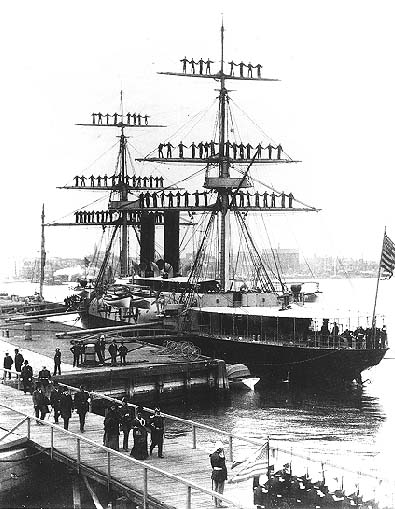
Manning
the rail: Sailors of the USS Abraham Lincoln man the
rails during her
return to port after participating in Operation Iraqi
Freedom
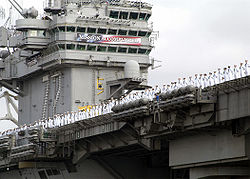
[Janet
Jaguar]
Masts have several uses other than
carrying sails, for spotting platforms, aerials,
derricks, anything that needs
to be higher than the deck really, so the masts would
remain even if sails were
never set on them.
Masts on these sloops would be probably be wood and
assembled in two or three
parts, hence the reference to the sending down of
topgallant and topmasts,
usual in preparation for heavy weather, in order to
reduce the weight and wind
resistance high on the ship, technically known as
tophamper. [dorbel]
[AND]
Someone queried the matter of topgallant masts on steam
ships. Masts were very
high, with topgallants to get wireless aerials as high
as possible. [navalhistory]
Invented by Hiram S. Maxim in the U.S. in 1884, the Maxim
Gun comprised the world's first automatic machine
gun. When
war in Europe broke out in the summer of 1914 the major
armies largely made use
of machine guns based upon Maxim's original design. The
Maxim Gun was
water-cooled and fed from fabric belts. 1914 machine
guns weighed from
40-60kg. The Maxim was usually operator by a four to six
man team.
http://www.firstworldwar.com/atoz/mgun_maxim.htm
[Janet Jaguar]
'Paid Monthly Payment' -. this is
in the days before the widespread use of bank accounts.
I think the way it used to work for married personnel
(and also families of
single men if they wanted), was for the serviceman to
decide on an allocation
of his pay. Part was available for him to draw on
locally and the balance
was available to a nominated person at his home port. [Haywain]
Senior warrant officers, the Gunner, the Bosun, the
Carpenter and the like are
always referred to as Mr by the
immemorial custom of the service. [dorbel]
Negative "anything" is
navyspeak for omit, leave out, cancel, or as the lower
deck would say,
"scrub round it". It comes from the days of flag hoists,
where the
Negative flag turns the accompanying signal into "do
not". [dorbel]
Neptune See Patent Log
Night clothing is not pyjamas, but
just the old casual clothing that a seaman wears on his
off duty evenings
aboard. An old shirt, a patched pair of trousers, a
sweater, that sort of
thing. [dorbel]
Record of Observations for Deviation
See Swinging the ship
Muster by the Open List - This is a
muster of the entire ship's company, wherein each
member, in alphabetical order reports name, rank and
duties on board to the captain. This practice
originated to counteract the practice of some ship's
pursers of having
non-existent people on the ship's rolls (and thereby
pocketing the pay and
benefits of these non-people). [dorbel]
Otters are paravanes [navalhistory]
I think "P.V." is being used for Paravane. These
are described as underwater kites, used to stream wires
away from
ships for minesweeping or other purposes and invented
during WW1.
http://en.wikipedia.org/wiki/Paravane_(weapon)
[Haywain]
[AND]
The RN did use towed devices for a number of purposes.
Towed paravanes
were used for mine detection and destruction, as
Badskittler stated. The
towed body was shaped like a seal and was used to draw
strong cables out from
the ships side. It was hoped these would snag on the
cables of moored mines. I device on the cable would then
fire to cut the wire on the mine. Once
released it would float to the surface where it could be
destroyed by gunfire.
The devices used on HMS CHRISTOPHER had hydrophones to
listen for the acoustic
signatures of submarines, what was known in those days
as HE or Hydrophone
Effect. Getting the hydrophone away from your own ships
noise was
essential to have have any hope of success. You wil note
that HMS
CHRISTOPHER always reduces speed to 10 kts or so when
streaming the Fish - this was because this was
her
best search speed, a combination of quietness but
tactically useable speed over
the ground. Haywain (my Captain?) you are correct about
Portland and Weymouth
Bay - there used to be a lot of acoustic research done
in this area. [TenDown]
[AND]
http://www.navy-net.co.uk/history/50867-1919-diary-id-12.html
reply #114 [Bunting
Tosser]
Parchment - The old naval name for a
rating's Service Certificate which, until the 1914/18
war, was on real
parchment. [Caro]
"Log inboard" is simple: they pulled in the Patent
log they were dragging.
Stream/streaming the log: drop patent log into water
behind ship / are
dragging patent log behind ship
All navy ships, pre-GPS, dragged instruments behind them
to measure their speed
through the water, or simply dropped them (originally
logs of wood) in the sea
and measured how quickly the ships passed them by
feeling how many knots in the
attached rope slid through their hands. Recording these
measurements is critical to being able to estimate
location, so the book they were recorded in was called
the 'log book', and the speed recorded was the number of
knots, not bothering to ever translate it into length.
http://forum.oldweather.org/index.php?topic=1221.0
As technology improved on logs, they came to be called
'patent logs'.
Quote from:
nearchus on
October 17, 2010, 12:21:41 PM
The
Admiralty
Manual of Seamanship in use in WW1 describes two towed
logs (Trident
electric and non-electric)and one bottom log (Forbes'
Ship's Log and Speed
Indicator). The towed logs were secured aft in the ship
and the rotator
streamed astern on a log line. The bottom log used a sea
cock in the bottom of
the ship and consisted of "a manganese bronze tube
having one opening
facing forward for the admission of water as the tube is
carried forward by the
ship, and another opening facing aft to allow the water
to escape. Between
these two openings is a propellor operating the
transmitting mechanism, and so
designed as to make a certain number of definite
revolutions while the ship
travels one sea mile". This log had both distance and
speed indicators.
The sea cock allowed the tube to be drawn upwards
through the bottom of the
ship and the aparatus could then be cleaned etc.
The advantages of the bottom log were many, including
the freedom from likely
damage if the ship goes astern, not vulnerable to damage
from other ships in
company, readiness for use at any moment and accuracy
over a wide range of
speeds.
http://en.wikipedia.org/wiki/Pitometer_log#History
http://en.wikipedia.org/wiki/Chip_log
http://en.wikipedia.org/wiki/Knot_%28speed%29
Brand names for models of patent logs are 'Neptune',
Trident and 'Cherub' -
just in case someone records dropping an angel
overboard.
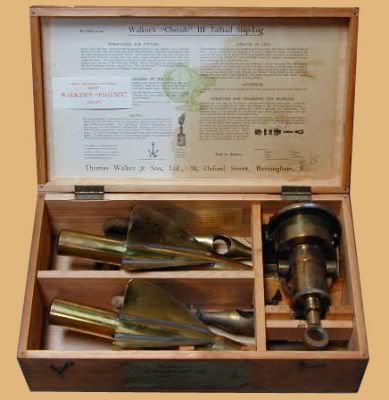
[Janet Jaguar]
I think that the hands are indeed "Paying
down" the cables, but I take this mean to mean
oiling them after
cleaning off any surface rust and examining them closely
for wear. Paying down
was certainly used in this sense for running rigging in
sailing ships and you
also "pay" deck seams with pitch. [dorbel]
I found this as a def. for Pendant.
(Transport / Nautical Terms) Also called pennant
Nautical a length of wire or
rope secured at one end to a mast or spar and having a
block or other fitting at
the lower end.
The flag that is dipped as a salute is an ensign,
presumably fixed to a pennant
or pendant. [dorbel]
[AND]
The Pendant is a flag indicating the presence of the
senior officer of a group
of ships so that the others know where to report, and to
pay attention to any
orders by signal flags shown on that ship. [Bunting
Tosser]
[AND]
Wiki says a Broad pennant/pendant
is: a swallow-tailed tapering flag flown from the
masthead of a ship to
indicate the presence of a commodore on board. It is so
called because its
dimensions are roughly 2:3. [Caro]
Auction of Personal Effects -
"Sale of effects - started at least in the 18th century,
and finished, I
don't know when - during or after World War 2? When
someone died or was killed,
their personal effects - clothes etc. were auctioned off
and the proceeds sent
to their next of kin. I believe that if the man was
popular, his mates or
oppo's (opposite number) would sometime pay ridiculous
prices for ordinary
items just to make sure, say his widow, received a good
sum." Quote from I
question I had asked navalhistory [elizabeth]
[AND]
Whilst it may seem impersonal, it would have been much
easier to ensure the
money got back to the relatives rather than their
effects. A lot more
opportunity for things to go missing in transit. As
Gordon has said,
there is plenty of evidence that depending on their
circumstances, prices
became inflated to help reduce immediate hardship. There
was also the
thought that one day it might be their belongings being
auctioned to help their
own dependents. [Haywain]
Pipe All orders passed out to the
entire company over the tannoy are preceded by a pipe, a
signal blown on a
small whistle by a Bosun's mate. Pipe
down is blown to tell the ship's company that it's
bed time. You might not
want to sleep, but you must keep quiet. [dorbel]
[AND]
History and sample in wave format:
http://www.navy.forces.gc.ca/cms/5/5-a_eng.asp?id=506
Mess Call - The pipe Mess call is the longest of the
lot; it should cover not
less than a minute. It consists of All hands, a long
Heave around., and a long Pipe down, in that order [szukacz]
Pintle (and gudgeon) -. hold the
rudder on to the boat, while allowing it to move from
side to side.
http://en.wikipedia.org/wiki/Pintle [Tegwen]
Pitching, Rolling, Pooping -
Pitching is the bow going up and down, while the stern
does the opposite.
Rolling is as it says rolling about the long axis so the
top of the mast is going from side to side. [Tegwen]
[AND]
Rolling is far more dangerous in terms of buoyancy.
While taking water is never
good, generally speaking a ship won't sink as long as it
has headway and can
take the seas on directly. However, if it takes waves
from the side (rolls),
the risk of broaching -- that is, rolling over -- is
significant.
Then there's the risk of a following / cross sea
slapping the vessel in the
stern and checking its way -- or "pooping." When that
happens, it is
possible for the ship to suddenly turn, roll and broach
to.
That's why, in the logs, you occasionally see course
corrections, during heavy
seas, to turn into the wind. (Usually, the seas and the
winds are running in
the same direction. But not always.) As a rule, in a
heavy sea, taking the
waves head-on is the safest option. [Doug
Vanderweide]
[AND]
In a 'heavy' sea (i.e. lots of wave movement with a big
difference (2-3m)
between the peak and trough (bottom) of the wave), ships
will pitch and roll at
the same time and usually end up doing a corkscrew
movement. The bigger ships
tend to move about less (inertia, mass, displacement etc
etc), but smaller
ships like destroyers, frigates, sloops would constantly
be smothered in sea
water with their crews soaking at their stations. Ships
with high sides and
flat bottoms (early aircraft carriers) were even worse.
[Gixernutter]
[AND]
"Actually setting sails" in the "What does that mean?"
section. Wendolk draws our attention to HMS Foxglove,
sailing South across the
China Sea in 1923 in a heavy swell and setting staysails
on both masts to
counteract the rolling. Her relatively shallow draft
made these little sloops
very vulnerable in a sea and the sails would have helped
a lot to make everybody
more comfortable. [dorbel]
. the Plotting table, where all
the info is co-ordinated to be sent to the guns. The
"table" on the
more modern WW1 ships was actually a sort of mechanical
computer developed by
the navy and operated by 8 men twirling little wheels!
They entered the
bearing, distance, course and speed of the target, along
with the course and
speed of their own vessel and came up with a direction
and elevation for the
gunners to use. Could be shockingly accurate too. [dorbel]
Interestingly enough, Wikipedia's article on the Maxim
gun mentions that it was
sometimes called the "Pom-pom"
due to its sound.
http://en.wikipedia.org/wiki/Maxim_gun
[CHommel]
3 pounder - Refers to a gun which
fired projectiles weighing approximately three pounds. [loerie]
[AND]
QF 3 pounder Hotchkiss -
http://en.wikipedia.org/wiki/QF_3_pounder_Hotchkiss
[Bunting
Tosser]
Pratique is the license given to a
ship to enter port on assurance from the captain to
convince the authorities
that he/she is free from contagious disease. The
clearance granted is commonly
referred to as Free Pratique.
A ship can signal a request for "Pratique" by flying a
solid yellow
square-shaped flag. This yellow flag is the Q flag in
the set of International
maritime signal flags.
http://en.wikipedia.org/wiki/Pratique
[montanaisaleg]
Priming Mines - Fixing the fuses and
first explosive charge so that they will go off. [Tegwen]
An able seaman will certainly want to advance and that
is initially by
examination. He can pass for a Leading Seaman and then
for Petty Officer, but
his actual Promotion will come with
a vacancy and his captain's recommendation. A Petty
Officer promotion will
usually come with a change of ship. [dorbel]
Quick Firing (Q.F.) Guns (Q.F. guns
are also loaded at the breech end.):
http://www.hnsa.org/doc/br224/part1.htm [Caro]
[AND]
Rank -
http://www.naval-history.net/WW1NavyBritish-Ranks.htm
[navalhistory]
A Rating is any man below officer
rank. [dorbel]
I have seen the phrase "Read
stations for. " a few times. It seems to mean that
they read out to
the relevant crew members what they need to do, when and
where. ie gave out
instructions before they started to do something that
they haven't done very
often,. [Tegwen]
Recommissioned - The only thing that
I would add to these interesting and informative posts,
is that crews get very
set in their ways, from officers down to scullions.
Breaking them up and moving
them on prevents bad habits becoming routine and of
course teaches old dogs new
tricks. This is particularly true of small ship's
companies, where discipline
is usually easier than in the cruisers and battleships.
[dorbel]
Red - Port.
Navigation lights - Port Red, Starboard Green
Imagine a line down the middle of the ship, bow to
stern, and extended
forwards. Anything to the left would be "Red x degrees"
or to the
right "Green y degrees". [Bunting
Tosser / edited]
Red oxide was (and is) the best
primer for protecting steel and wood from the sea.
Provided you didn't actually
eat the stuff it wasn't harmful to health although the
dust from chipping and
grinding it off again undoubtedly was. It's use on boats
was largely banned due
to its detrimental effect on sea-life.
[Also called red lead] [dorbel]
[AND]
"red lead" is another name for lead tetroxide, ".most
often
used as a pigment for primer paints for iron objects.
Due to its toxicity, its
use is being limited. In the past, it was
used in combination with linseed oil as a thick,
long-lasting anti-corrosive
paint."
http://en.wikipedia.org/wiki/Lead_tetroxide
[CHommel]
To the best of my knowledge the larger warships did have
Refrigerators, and there were refrigerated cargo
ships carrying
meat from Australia, Argentina, New Zealand etc. [navalhistory]
Rolling See Pitching, Rolling,
Pooping
Rounds Correct
Well what actually happens is that the officer of the
watch, with a small
entourage (a CPO and a midshipman perhaps) tours the
ship, covering every
station where duty men are closed up, as well as the
galleys and the mess decks
which have been prepared for inspection, i.e. clean and
tidy. As he reaches
each section a PO or Leading seaman will report and
accompany them on to the
next part of the tour. Unless something is horribly
wrong, a word in the ear of
the man responsible ("See to it that those mops and
buckets are properly
stowed away Killick") is plenty and "rounds correct"
means that
the whole timeless procedure has been carried out,
rather than that everything
was perfect. Discipline was and probably still is strict
in the Royal Navy, but
there is a great deal of informal give and take,
particularly in the small
ships and it is no coincidence that "to turn a blind
eye" is a naval
expression.
[AND]
Rounds are always correct, because minor imperfections
are not meant to be
noticed (the pile of dust hastily swept under a coiled
cable) and major
imperfections, a man not on duty for example is
immediately rectified and dealt
with at defaulters parade the next day. Nobody on board
has anything to gain by
noting a list of things that are wrong in the log for
their Lordships to
contemplate, least of all "Jimmy The One", the First
Lieutenant who
is responsible for just about everything in this line. [dorbel]
Route marching is marching over
rough ground, usually with full kit, and would be for
when your ships company
(especially if they had marines) needed to operate as a
landing party.
Ceremonial marching is what the tin says. It usually
takes place on a parade
ground or flat piece of ground and consists in marching
according to shouted
orders. It often involves rifle drill - 'present arms'
etc. This would be used
if providing guards of honour at events or if taking
part in formal ceremonies.
[studentforever]
Rove - It's the past participle of
"to reeve", to pass a rope through something. A slip
rope is one that
moors to the quayside in such a way that the crew can
release it from the ship
and retrieve the rope, rather than having to rely on the
dockside workers to
unhitch the rope at the correct moment. [dorbel]
A Sail loft is an upper floor in a
building where sails are made. It is large enough for
the entire sail to be
laid out and worked on. If sails were made flat this
wouldn't be necessary, but
the square sails of square-rigged ships are stitched
together from bolts of
canvas so that they have a "belly" and for this you need
to have the
whole sail laid out.
Many RN ships at this time could and did set sails; we
note Foxglove setting
fore and aft sails when on a long beam reach as late as
1922 and of course
there were still a lot of sailing ships trading, so the
sail loft was still a
feature of most ports. [dorbel]
Seedies and Kroomen (also Kroumen or
Krumen)
http://en.wikipedia.org/wiki/Seedies_and_Kroomen
[Janet Jaguar]
[AND]
All is explained in great detail at
http://portal.unesco.org/culture/en/files/38503/124697397957._Black_Liberators.pdf/7.%2BBlack%2BLiberators.pdf
[dorbel]
[AND]
A seedie boy is an East African or Indian native
labourer working in H.M.
Ships. Don't let the term "boy" conjure any images of
young, strong
men. I think the oldest "Boy" I've encountered was in
his late
70s. They did get all the dirty jobs. Being PC wasn't an
issue then. [kin47 - Don]
Shackles were a measure of the
length of cable. According to a 19th Century Seamanship
Manual, ships were
usually equipped with 12 shackles of bower cable where
each shackle was a 12.5
fathom length. These 12.5 fathom lengths were joined by
shackles (hence the
name) and by swivel links to overcome twisting. When
paying out the anchor
cable, counting the number of shackles passing gave a
measure of the length
used. In 1949, the Royal Navy switched from 12.5 fathom
shackles to 15 fathom
shackles. Modern heavy mooring chain is usually sold in
15 fathom lengths or
'shots'. The specification sheets quote the number of
links per shot. Here is a formula for calculating
the
amount of anchor chain to put out in your warship:
Twice the square root of the
depth of water in fathoms = the number of shackles of
cable. [AvastMH]
Definitely Sheering (considerably),
a particularly nasty phenomenon where wind and wave
carry you back over your
own anchor. The danger in this situation is that you
foul the anchor chain
around your propeller and/or rudder, greatly increaing
the risk of plucking
your anchor out of the ground with the extra leverage
and then being blown
ashore unable to use your engines because of the chain
around the prop. Not
unheard of to be driven ashore in this way. [dorbel]
Sheet anchor - an extra large anchor
used in emergencies [wendolk]
Pretty standard to Sink any floating
object out at sea, empty lifeboat, drums, barrels
etc. Good gunnery
practice and means that your patrolling vessels won't be
altering course to
investigate them in the future. A ship that has sent 400
men to action stations
because an alert lookout has spotted a periscope that
turns out to be an old
fisherman's net marker delights in smashing it to
pieces. [dorbel]
"'All hands to dance and skylark'
was historically a command from a ship's officer for his
crew to take brisk
exercise in the fresh air, shinning up and down the
rigging (hence 'skylark').
It was given when, confined at sea, the men became
sluggish and listless; so it
was, if you like, an early form of fitness training." [wendolk]
Slops. Clothing, tobacco, etc.,
issued from the ship's slop-chest by the paymaster.
Unlike "issue"
(q.v.), slops must be paid for.
http://www.naval-history.net/WW2aaNavalLife-Customs2.htm
[AND]
Uniform for ratings was first established by the
Admiralty in 1857. Prior to this, most seamen wore
"slops", or ready-made clothing sold to the ship's
crew by a
contractor; many captains established general
standards of appearance for
the seamen on their vessel, but there was little or no
uniformity between
ships. On one occasion in 1853, the commanding officer
of HMS Harlequin paid
for his boat crews to dress as harlequins, an incident
which may have
contributed to the Admiralty's decision to adopt a
standard uniform. (sorry,
couldn't resist)
http://en.wikipedia.org/wiki/Royal_Navy_uniform
[randi_2]
Sounding Machines -
Ships in unknown waters like to know the depth of water
underneath them. Also,
charts are marked with the depth of water, so it is a
navigational aid.
In early days they found this out by sounding, that is
dropping a heavy weight
on a long piece of rope over the side, letting it sink
to the bottom and
marking the length of the rope used.
By WW1 this process was a little more sophisticated and
a thin wire with a weight [and tube] was used, lowered
and raised by a powered winch. The tube is there to
collect samples from the sea bed. It was driven into the
sea bed by weights, a flap closed and when it was
brought to the surface the tube contained a sample. The
material on the bottom (mud, sand, shell for example) is
also useful information [dorbel
/ edited by randi_2]
[AND]
http://titanic-model.com/db/db-03/kelvin.html
- Describes and illustrates Kelvin Sounding Gear. I
think the Royal Navy gear
was very like this, although the surveying vessels,
which could sound to depths
of over 1,000 fathoms, may well have had something more
sophisticated. They
even allowed for the speed of the vessel through the
water. [dorbel]
[AND]
From the Seamanship Manual section on Sounding Machines:
"The glass
chemical tubes are coated inside with chloride of
silver, which shows red, but
is turned white by the action of the water. Thus, the
deeper the tube goes, the
greater the pressure and the further the water is forced
up the tube." [navalhistory]
Splice the Main Brace -
http://www.royalnavy.mod.uk/sitecore/content/home/news-and-events/latest-news/2012/june/27/120627-royal-navy-splices-the-main-brace
[randi_2]
Spoke for seamen of that era really
did mean that, with a megaphone! Radio was still morse
code and flag or aldiss
lamp signalling with merchantmen notoriously cumbersome.
They closed and
shouted. [dorbel]
Gun barrels were regularly Pponged out,
as the cordite propellant in use at this time was highly
corrosive and could
quickly damage the bore of the barrel. [dorbel]
[AND]
Ahem.
"spongeing" is the correct Br. Eng.
spelling (not always used on dry cleaners' signs);
otherwise you have a hard "g" as in "springing". [Bunting Tosser]
Spotting Table See Fire Control
Table
"running out Springs". In
the naval sense, a spring is a rope running from the
side of the ship to the
anchor cable or to bollards on the shore.
If it is running to the anchor cable from a point on the
side of the vessel, it
enables you to adjust your position in relation to the
anchor by hauling on the
rope, or slacking off. More commonly when moored
alongside a jetty or wharf it
runs from ship to shore at a diagonal. It will prevent
the ship surging
backwards and forwards. When moving away from the side,
it can be used to
manouevre the bow or the stern away from the wharf by
hauing on it or slacking
away. [dorbel]
[AND]
"Coir Springs: Heavy duty harbour moorings manufactured
in coir rope. They
are designed to be picked up by a vessel mooring in a
harbour, usually where
heavy swells are experienced.
http://www.pomorci.com/Edukacija/80-100/Definitions,%20terminology%20and%20shipboard%20phrases.pdf
[Bunting
Tosser]
To Stand off and on (Naut.), to
remain near a coast by sailing toward land and then from
it. [Caro]
[AND]
It may include tacking. If you follow any of the 'old'
naval stuff (Hornblower,
Nelson, 'Master and Commander,' etc.) the British and
/or the French would
'blockade' the other's ships in harbour to keep them
there. It entailed in some
cases MONTHS of just sailing back and forth off shore to
keep the enemy bottled
up. That was considered 'standing off and on' to the
shore. [dmaschen]
Starshell -
http://www.firstworldwar.com/atoz/starshell.htm
[szukacz]
[AND]
I found a discussion on Naval History
Forums: Battleship Bismarck Forums, that indicates
star shells were
special shells used to illuminate enemy ships for night
battles. Based on
what Szukacz found, it seems they were used on land as
well. [wendolk]
Steaming lights are the lights
carried by all ships at night. They include port and
starboard lights of red
and green, a white mast light and stem/stern lights. [Tegwen]
The Royal Navy didn't have Trimmers just Stokers,
who were an all encompassing Marine Fireman. The Stoker
was trained in the
loading, distribution, storage and use of coal. The
basics of a Royal Navy
steam propulsion system that uses coal, has to use three
compartments firstly
the bunkers where the coal was stored, then the
stokehold where the coal was
held until required to be sent down chutes to the
boilers.
Bunkers where strategically placed around the ship and
used as extra armour by
being placed between the outer skin and the
boiler/engine rooms, so usually
long thin compartments. Coal also came in different
grades and calorific values
the lower values being used for normal cruising, the
higher saved for exercise
or battle and stowed near the stokehold (Welsh coal
being the preference).The
location of coal within the ship would effect the ship's
"trim"
(i.e., if all of the bunkers on one side of the ship
were emptied, she would
lean drastically to one side), so the use of coal was
monitored to keep the
ship in trim. This was supervised by the Chief Stokers
and their tanky's the
water used to feed the boilers was also a large part of
this equation both in
what was used and what was produced.
As you could imagine during normal cruising this was a
calm steady process,
well oiled and managed by the Chief Stoker with Stokers
manning or managing the
three parts of ship, this gave the younger Stokers time
to train and perfect
their skills. A large ship would use 500 tons of coal a
day under normal
cruising conditions, three times that if on exercise or
in battle conditions.
The bunkers were hot, often humid, and the air thick
with coal dust. Each
bunker had to be periodically emptied totally and the
build up of dust cleaned
out to stop the chance of spontaneous combustion, caused
by the coal absorbing
moisture and creating heat which would build up until
the coal began to burn, a
problem to put out usually done by flooding the bunker
pumping out and then
using the coal straight away.
Working within the bunkers was a terrible job. Since the
coal bunkers could be
long, men had to shovel the coal around in the bunkers,
so that the bunkers
could be filled evenly. When the coal was being used, a
shovel relay would be
set up in the bunkers, so that the coal in the bunker
could be used evenly, and
a ready supply kept at the entrance to the bunker for
transfer to the
stokehold. From this point it was shovelled in
manageable quantities into the
boiler rooms.
The job of 'Trimming' the bunkers was normally done by
Sailors and Marines and the first place any army
embarked where employed, this task was supervised by PO
and Leading Stokers. The Stokers moving the coal from
the stokehold to the boiler rooms and feeding the
furnaces. [Bunting Tosser
/ Charles]
Stop - A piece of small line, or the
like, used to bind or secure something; as, to secure a
furled sail with stops.
[randi_2]
Stream Anchor - A light anchor
sometimes carried at the stern of the vessel.
Alternatively called a stern
anchor or kedge anchor.
http://www.pomorci.com/Edukacija/80-100/Definitions,%20terminology%20and%20shipboard%20phrases.pdf
[randi_2]
. you Strike a flag when you lower
it. [dorbel]
Worth noting that at this time Suicide
was both a crime and a sin. Successful suicides could
not be buried in
consecrated ground and there was a great sense of family
shame attached to it.
Hence authorities would bend over backwards to find a
form of words that
avoided stigmatising the unhappy person concerned, as
appears to have happened
here. [dorbel]
[AND]
If the suicide was due to an action while the person was
of unsound mind, it
was not necessarily as serious in the legal text. And
some allowance
could be made to the next of kin. Exceptions to every
rule, but this
should be known. [kin47
- Don]
Swinging the ship - Magnetic
variation is the difference between true north
(geographic north) and magnetic
north. Deviation is the difference between magnetic
north and ships compass
north. It is due to the distortion of the magnetic field
as it passes through
the various metal parts of the ship before it gets to
the compass. Thus deviation
[ShedMonkey] is different for every compass point on
which the ship steers.
When a ship comes out of dock she has her compass
"Swung" which
entails swinging the ship around a known point so that
she points at at marks
ashore the true direction of which is also known. A
deviation table is then
compiled. It follows that the table is applicable only
to that specific ship at
that specific time. [Cunimb]
[AND]
Compass "Error" is the combination of variation and
deviation and it
will usually be one of a watchkeeper's duties to check
compass error (and
thereby derive deviation) every watch either by
observing a geographical
transit, or by celestial observation - Azimuth or
Amplitude. In these days of
gyro compasses, this is still a duty of a navigator, but
gyros don't suffer
from variation or deviation - they just have "error" -
but nowhere
near that of a magnetic compass. [ShedMonkey]
Example:
http://oldweather.s3.amazonaws.com/ADM%2053-75689/ADM%2053-75689-017_1.jpg
http://oldweather.s3.amazonaws.com/ADM%2053-75689/ADM%2053-75689-018_0.jpg
[AND]
http://www.compassadjustment.com/#4 [dmaschen]
[AND]
http://myreckonings.com/wordpress/2009/04/18/magnetic-deviation-comprehension-compensation-and-computation-part-i/
"Magnetic Deviation: Comprehension, Compensation and
Computation (Part
I)" [Bunting
Tosser]
[AND]
They put iron shims [thin wedges] in to counteract the
magnetic effects of the
metal around the ship, of which of course there is
loads, but the magnetic effect
of the ship can change due to slight moves of plating,
guns etc. The shims are
placed so as to neutralise the effects of all those
changes ensuring that the
main effect on the compass is the earth's magnetic
field, not the ships. [Tegwen
/ Janet
Jaguar]
Swinging to flood tide - I believe
it indicates that the ship is riding at one anchor
(usually the bow) so that
the ebb tide had carried the stern away from land. When
the tide turns, the
current - being in the opposite direction - will push
the stern around. It's just physics or hydrodynamics, no
active participation from the ship's engine or crew,
although the result is as you describe - sharp end
towards the incoming tide. [Bunting Tosser]
Tacking and Beating
http://en.wikipedia.org/wiki/Tacking_%28sailing%29
[randi_2]
"Orcoma" at this time has 10-13 on the sick list every
day. TB was very much the lower deck
sailor's disease. Common in the population as a whole at
this time, the close
living conditions (all men still slept in a hammock that
touched that of his
neighbour), dampness, the very high number of smokers
and the seaman's
invariable habit of stuffing up any ventilation, all
made for ideal conditions
for the passing on of TB. In the notoriously damp HMS
"Hood" between
the wars, where sea water came down the ventilators into
the mess decks in any
sort of a sea when travelling fast, lower deck TB was
almost endemic. [dorbel]
"Telaupad is the contemporary
British term for headphones used in a variety of
shipboard applications, often
in Fire Control tasks where the operator had to keep his
hands free and be
attentive to a remote source of information and
command."
http://www.dreadnoughtproject.org/tfs/index.php/Telaupad
[thursdaynext]
Ships keep local Time wherever they
are, so on a voyage the clocks may change daily. When
clocks are put back it
makes the watch longer, very unpopular as you can
imagine, so it was often done
in in two stages, once in the first dog watch (4-pm to
6pm) and once in the
second, (6-8pm). [dorbel]
Time ball -
http://en.wikipedia.org/wiki/Time_ball [Caro]
I think "Told Off" means
"Assigned to" in the way it's used here - old military
speak [Haywain]
A naval Trawler is a vessel built
along the lines of a fishing trawler but fitted out for
naval purposes. Naval
trawlers were widely used during the First and Second
world wars. Fishing
trawlers were particularly suited for many naval
requirements because they were
robust boats designed to work heavy trawls in all types
of weather and had
large clear working decks. One could create a mine
sweeper simply by replacing
the trawl with a mine sweep. Adding depth charge racks
on the deck, ASDIC
below, and a 3-inch (76 mm) or 4 in (102 mm) gun in the
bows equipped the
trawler for anti-submarine duties.
http://en.wikipedia.org/wiki/Naval_trawler
[randi_2]
The Triatic stay ( I didn't know it
was called that either) serves the purpose of extra
fore-and-aft support for
the masts. It is possible, likely even, that this ship
will rig a derrick on
the foremast to lift the coal out of the lighter
alongside and swing it inboard
over a hatch in the fore deck. The weight of this will
of course tend to pull
the foremast forward, so the triatic stay will transfer
some of this load to
the mainmast.
The definition refers to mast heads, but I suspect that
this, in this case,
refers to the tops of the lower masts, rather than the
tops of the topmasts if
you see what I mean. You wouldn't want to apply any
strain to the peak of your
topmast. [dorbel]
Trimmers See Stokers
Uniforms / Dress
http://en.wikipedia.org/wiki/Royal_Navy_uniform
[Tegwen]
http://allnavy.blogspot.fr/2011/04/royal-navy-uniform.html,
http://www.seayourhistory.org.uk/content/view/640/808/1/2/,
http://www.pbenyon1.plus.com/Uniform/Phot/Index.html
[randi_2]
http://www.worldnavalships.com/forums/showthread.php?t=4294
(especially no.# 15) [Bunting
Tosser]
Up Spirits
http://www.naval-history.net/WW2aaNavalLife-Customs2.htm#6
[randi_2]
To Veer in this sense is to let out,
so they are increasing the amount of cable (or chain)
between the ship and the
anchor. This decreases the likelihood that they will
drag the anchor if the
wind gets up.
Not to be confused with veer in the
sense that a wind direction may veer, or move clockwise
around the compass
rose, e.g. "North, veering to North East later". [dorbel]
[AND]
It is actually the weight and drag of the anchor chain
(or cable) lying on the sea bed that keeps the ship
where it is. The flukes of the anchor do dig in of
course but once the cable is veered out, the strain on
the anchor itself should be minimal or non-existent. [dorbel]
He also received a War Gratuity,
whatever that was. Any comments?
A gratuity was a sum of money paid to servicemen and
women when they had
completed a period of service for which they were
contracted. it was an
inducement for those serving shorter term engagements
which did not entitled
them to a pension. The war gratuity will have been paid
for those who
volunteered for war service. (http://archiver.rootsweb.ancestry.com/th/read/GREATWAR/2000-06/0961106780)[Bunting
Tosser]
Warrant punishments are severe! We had one once
where a Petty Officer had a warrant punishment. The
whole
Ships company and all officers form up in their best No
1 uniforms. The
offender is marched in before the Captain. He is not
allowed to remove
his own cap - it is snatched from his head by the Master
at Arms standing right
behind him. The warrant is read and the punishment
starts there and then. The mans Petty Officers badges
are torn from his sleeves, his Good Conduct
Badges are torn from his sleeves and he is marched away
to RNDQ's (RN Detention
Quarters). The re-offender rate in the Navy is a
fraction of that in
civilian justice system. [TenDown]
Watches on board are four hour
watches commencing at midnight, except for the dog
watches, 1600 to 1800 and
1800 to 2000. The purpose of these is to arrange watch
keeping so that you
don't always come on watch at the same time every day.
Ships usually keep three
watches in port but revert to two watches 4 hours on, 4
hours off) at sea, Port
and Starboard. Not all hands are watch and watch about,
certain trades, cooks,
carpenters etc are day men, sometimes referred to as the
idlers. [dorbel]
Wearing (also jibe or gybe)
http://en.wikipedia.org/wiki/Wearing_ship [randi_2]
Wind hauling, veering and backing
I have come across the phrase "wind hauling" a couple of
time.
According to my 1928 Websters:
"To change direction, as the wind. A distinction is
often made between
haul and veer, as said of the wind. Perhaps the more
general usage is to say
that the wind hauls from north to west
(counterclockwise) and veers from north
to east (clockwise); but some authorities support the
contrary usage."
On the USS Rodgers, they seem to only use the term
hauling and they use seem to
clockwise and counterclockwise. [randi_2]
[AND]
I found a longer definition of wind hauling, veering and
backing, that includes
the various (contradictory) uses from different ships.
http://fer3.com/arc/m2.aspx/veering-backing-again-DanAllen-mar-2003-w9282
[Janet Jaguar]
[AND]
Hauling (veering is the modern term) is clockwise and
backing is
counterclockwise. in the northern hemisphere! If you are
in the southern
hemisphere, it's the other way around: hauling is
counterclockwise and backing
is clockwise. It is based on the way the wind changes as
weather fronts pass a
designated point. For the same weather pattern, the wind
changes opposite ways
in the north and south hemispheres, but the terminology
remains the same so you
know where you are relative to that weather pattern. [Jeff]
Wind sail - A wide tube or funnel of
canvas, used to convey air for ventilation into the
lower compartments of a
vessel. [randi_2]
Writer ratings keep all the books
aboard. Accounts, stores, personnel, anything really, as
well as typing all the
ships letters and despatches. A writer probably prepares
the copies of the logs
that we see. They are seamen, so have basic training in
seaman skills, but
"writing" is their speciality. A very large ship would
certainly have
a Chief Writer, but one imagines that a smaller ship
would be managed by a PO
Writer or even a Leading Writer. [dorbel]
Zig-zagging -
http://www.history.navy.mil/library/online/onipubno30.htm
By the way, failure to zig-zag was the main factor in
the court martial of the
commander of the Indianapolis. They'd just delivered the
atomic bomb and
were headed back when a Japanese sub got them. If you've
never heard that
story, and if you aren't easily unnerved, Google it. Or
watch the movie
Mission of the Shark. By the way, the commander of the
Japanese sub
testified at the court martial and said he would have
been able to sink him
even if he zig-zagged. Still convicted him. The US Navy
has since
admitted it was the wrong thing to do, but it remains on
his record because
there's no procedure for removing such a thing. Crazy,
huh? [DJ_59]
[AND]
. to avoid being predictable to reduce risks of torpedo
attacks from
Submarines? If I understand correctly they would not
always make the same angle
of turn and would vary the frequency while still heading
in the same overall
direction.
I haven't transcribed much of the N Atlantic convoy
ships, but those I have
done stopped zig zagging at night fall when it was more
difficult for subs to
spot them and make predictions about directions etc. [Tegwen]
11.
ARCHIVED THREADS
|